After I had visited Golubinci village that is actually the reason why I have thought about this trip in the first place (the village has less than 5000 inhabitants, it is situated merely some 40 km from Belgrade, but there are as many as FIVE important monuments of culture of different categories in it), I continued in line with the programme I had envisaged. The next destination was village Donji Petrovci (Доњи Петровци) and in order to get there I had to turn left from the main road in Putinci. First I went to the church, since the road was leading there anyway, because the church is categorised as immovable cultural property of great importance.
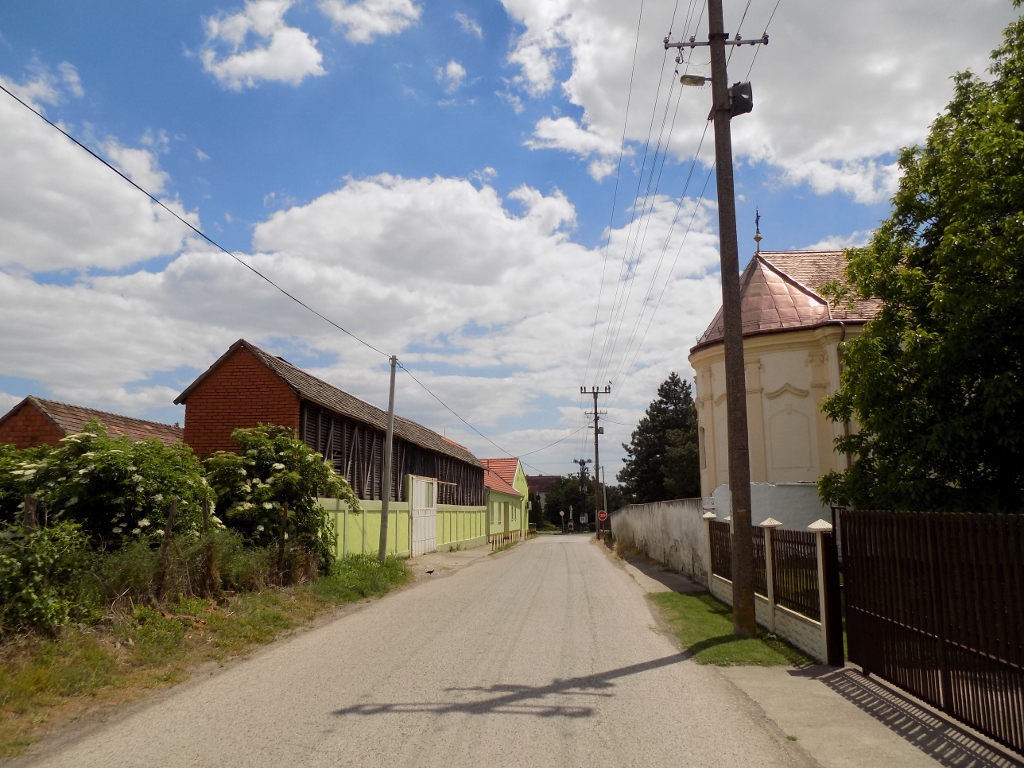 The road enters Donji Petrovci, while the Church of St. Nicholas is on the right-hand side
The road enters Donji Petrovci, while the Church of St. Nicholas is on the right-hand side
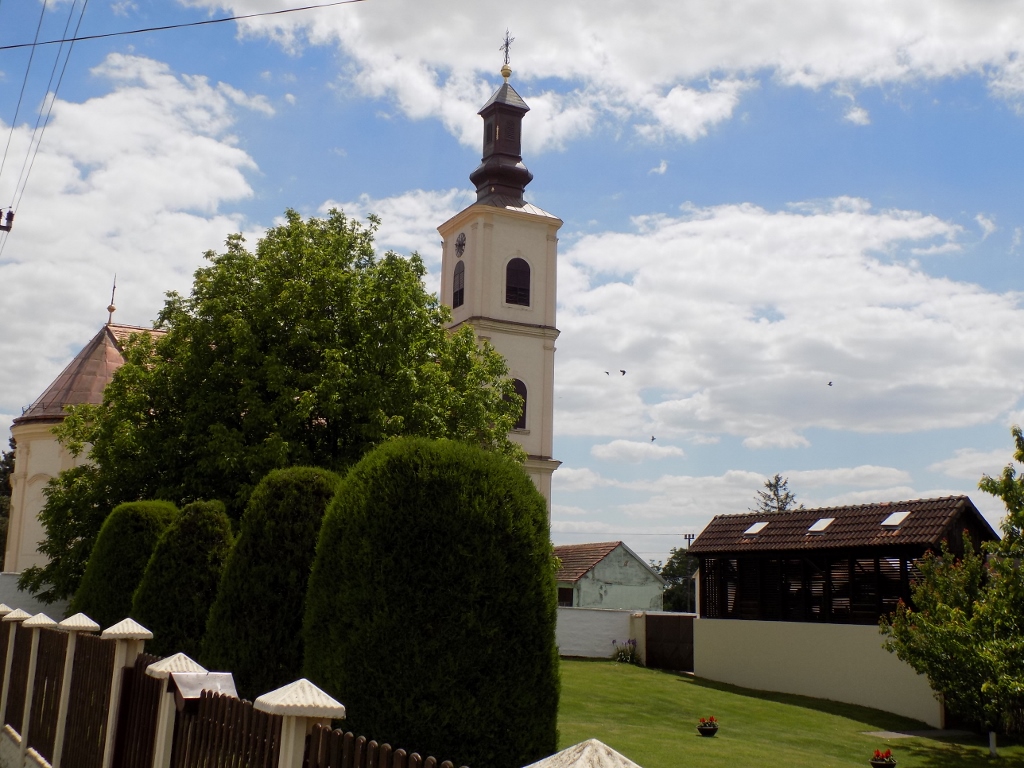 Church of St. Nicholas, Donji Petrovci
Church of St. Nicholas, Donji Petrovci
The church was built at the very beginning of the 19th century and it looks quite typical for the period and for this region. It consists of a single nave, the baroque bell tower is adjacent to the west facade, while the semicircular apse is on the east side.
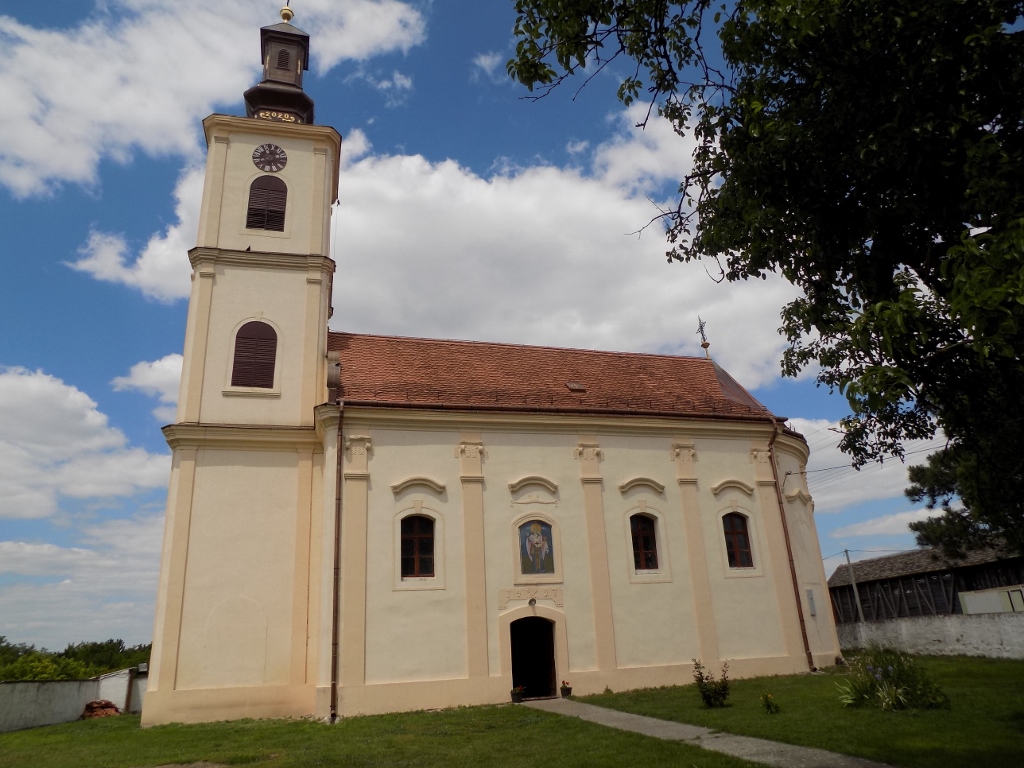 Church of St. Nicholas, Donji Petrovci
Church of St. Nicholas, Donji Petrovci
The lateral facades also have the typical decoration which among other things includes windows, while in the blind niche on the south facade that follows the form of the windows there is the depiction of St. Nicholas. The image of the saint is positioned above the south entrance into the church.
Here, too, the interior is dominated by the iconostasis the structure of which is made of richly carved wood with numerous decorative motifs. Within the iconostasis there are around 50 icons.
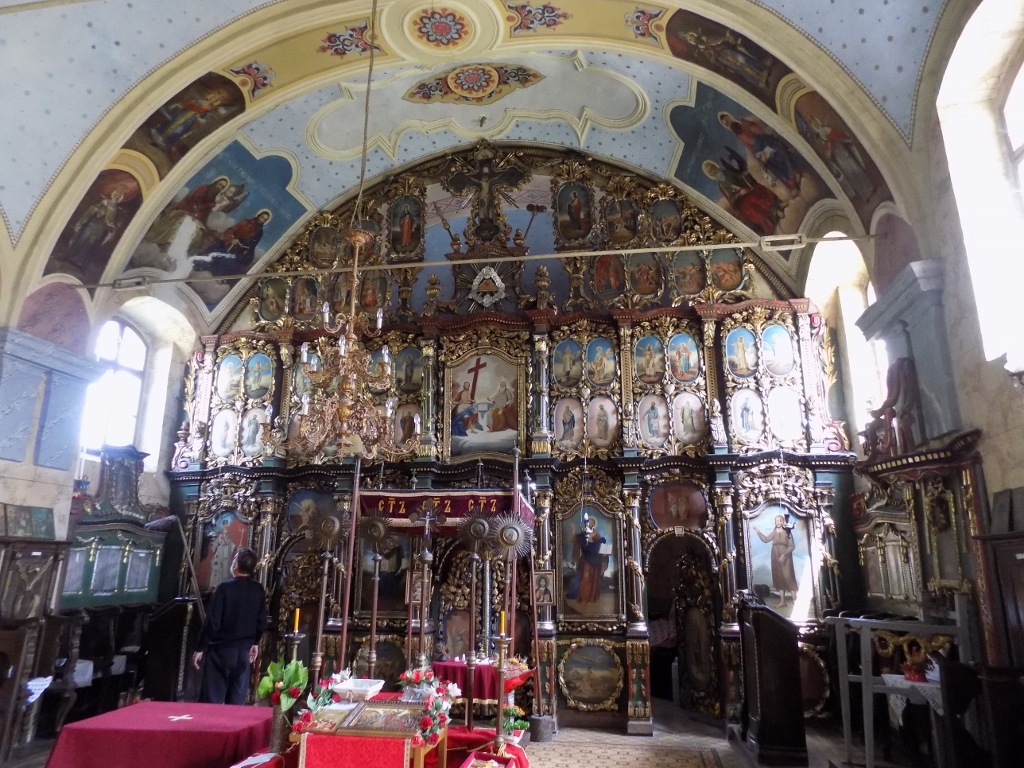 Church of St. Nicholas, the interior
Church of St. Nicholas, the interior
At the church I came across the priest who was getting ready to lock up, so I took the opportunity and chatted with him a little. I also asked him for some clarifications regarding a couple of other monuments of culture in Donji Petrovci, as well as concerning the continuation of my trip.
So, the documentation that I had consulted before the trip showed that there was a watermill in Donji Petrovci from the 19th century that was classified as the immobile cultural property of great importance. However, when I asked the priest about it, he said that there was no such watermill in the village. Afterwards, like a proper doubting Thomas, I also asked some women in a nearby shop, but they confirmed that there was no such watermill, with an addition that it had simply collapsed.
I also asked the priest about another local immobile cultural property of exceptional importance and there he explained to me where it was. Namely, on the outskirts of village Donji Petrovci there are remains of the Roman town of Bassianae. I went on foot to the place from which Bassianae could be seen, since this is quite close to the church, and along the way I also crossed a small bridge that went over the Jarčina canal on which the watermill used to be.
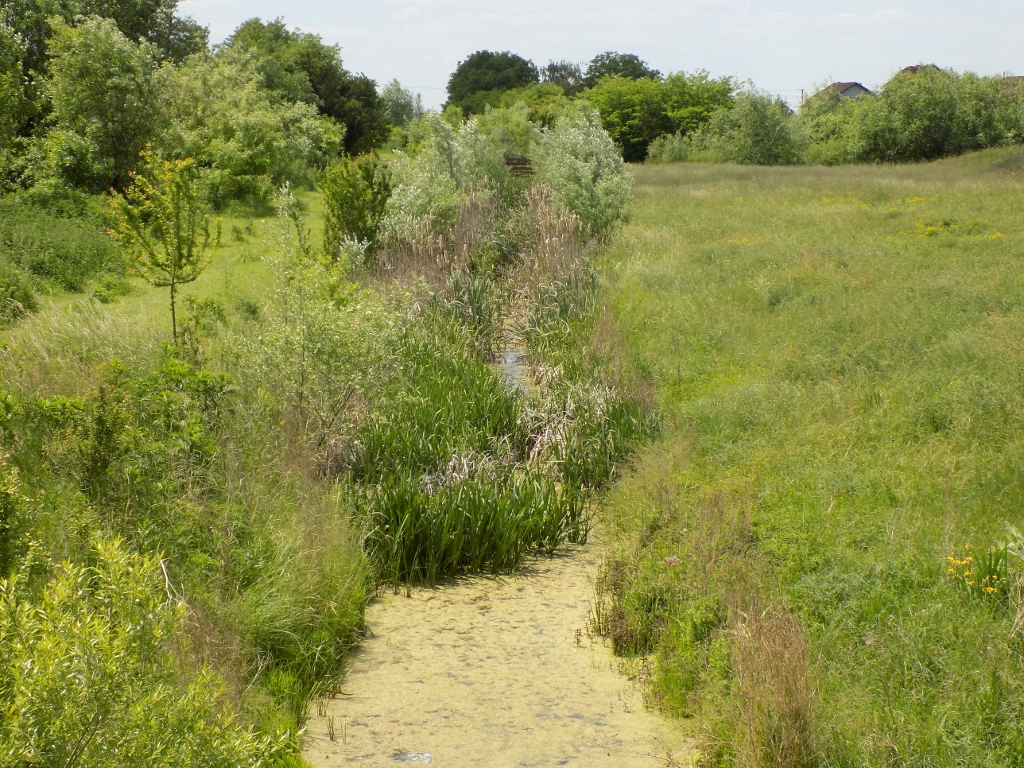 The Jarčina canal
The Jarčina canal
By the way, the Jarčina canal is the name for a system of rivers and canals in Syrmia with the total length of 53 km. It starts from Iriški Venac on Fruška Gora and flows into the Sava river. It is precisely the Jarčina canal that constitutes the south border of the archaeological site Bassianae, while the road from Putinci runs through the archaeological site itself. And yet, there from the road, one can see NOTHING. When you have the bird’s-eye view at the site (i.e., when you look at the satellite image in the Google maps), you can discern the contours of the ancient structures quite clearly, but so far this site has been very modestly explored. The bodies in charge have it obviously quite clear that this is a very important cultural property and hence its categorisation, but the thorough exploration and conservation of the site, as well as the rest of the things that go along are seemingly still not on the agenda.
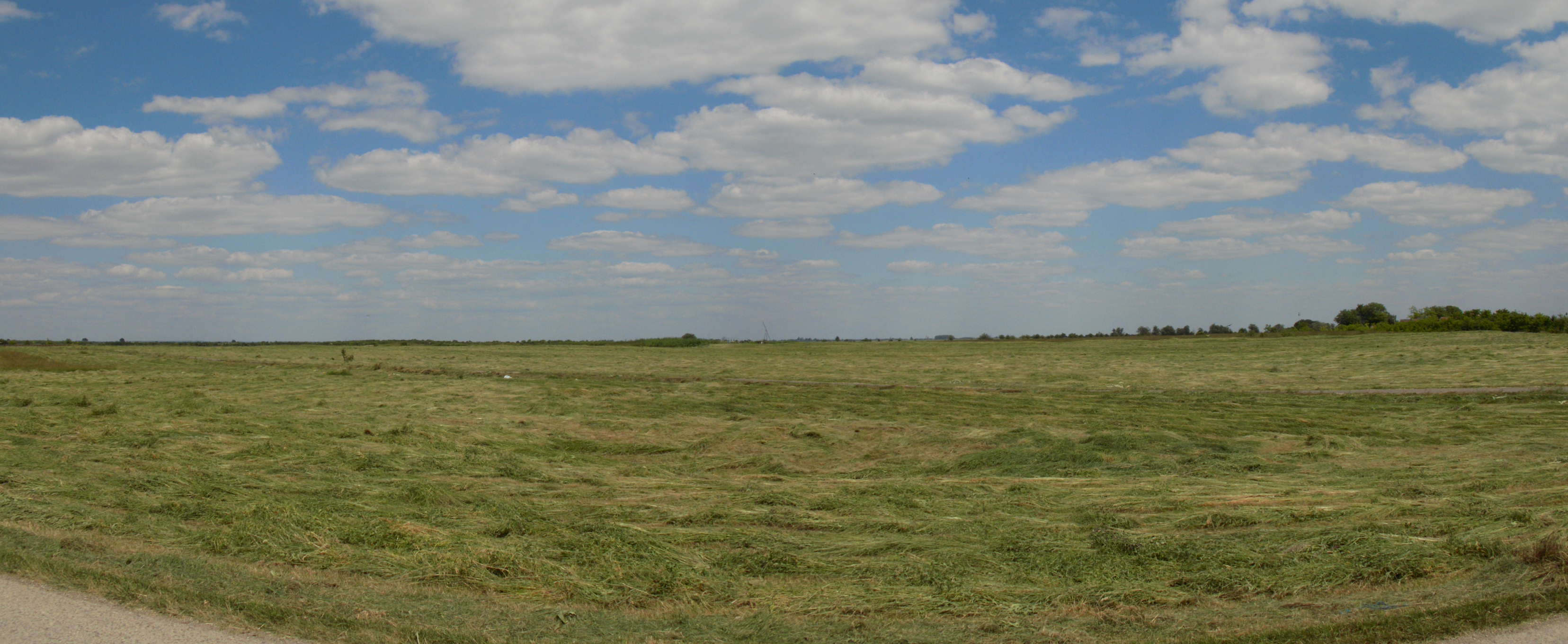
The first settlement was founded here in the 1st century CE, with Bassianae getting the status of town (municipium) in 124 CE and it functioned like that until the 6th century. After Sirmium (present-day Sremska Mitrovica), this was the second biggest town in the ancient Roman province of Pannonia. Smaller-scale archaeological explorations were conducted here at the end of the 19th century and in the first half of the 20th century, but since the site is not developed officially and as it should be, it is occasionally, unfortunately, frequented by thieves who dig out surface finds which they then sell, thus depriving my country and my nation of what is rightfully ours.
As there was nothing else for me to visit here, I went back to my car and then headed in the direction which I had believed was a good one and which had been corroborated earlier by the priest. Namely, before the town of Ruma, there were two more villages I planned on visiting, Kraljevci and Dobrinci, and according to the map (Google) I was supposed to go back to the main road, drive to Ruma and then round and around. I was sure that in practice this went more easily and more logically and I was right. In reality, there is a significantly shorter, direct road from Donji Petrovci to Dobrinci, but it is a gravel road. Not a problem for me! I drove slowly and made breaks in order to take photos. By the way, the road follows the Jarčina canal.
I was already out of the village and crossed a small bridge when I made my first stop. There were some gorgeous common/field poppies (Papaver rhoeas) that I adore. Way back when, in my childhood, I learned I should not pick them, since they wilt right away, but every time when I see them in nature where they adorn their surroundings so wonderfully I enjoy them with undiminished exaltation. Since they were abundant and frequent in Syrmia at the beginning of June 2021, they will appear quite often in the photos within the stories of this trip.
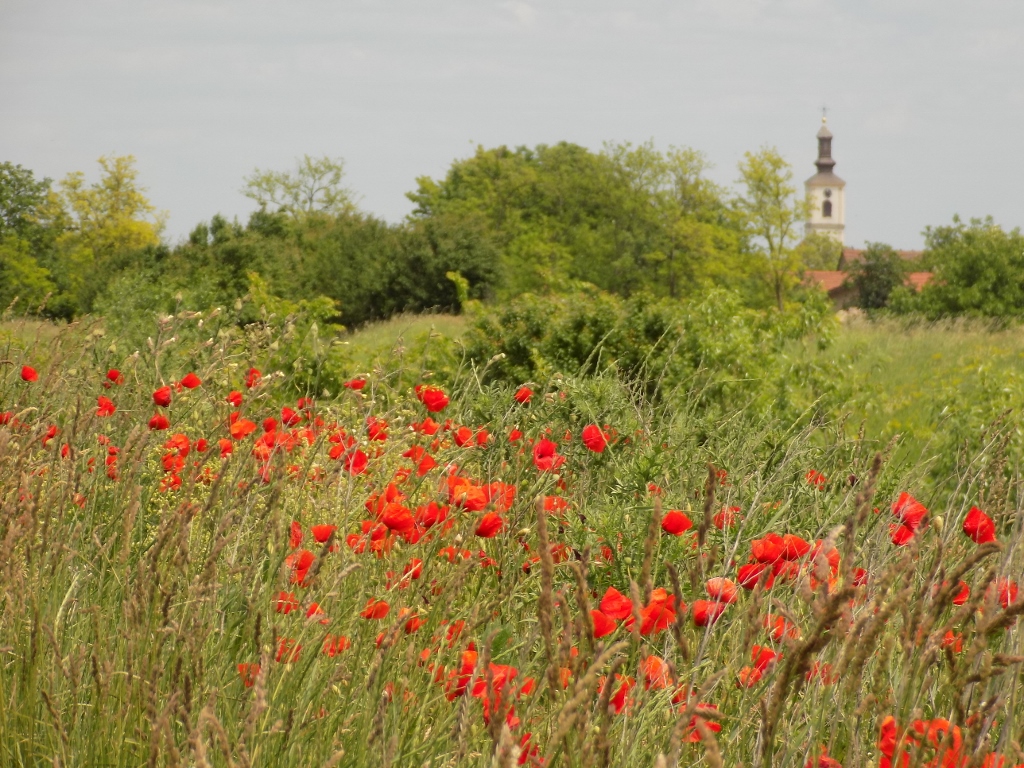 Field poppies with the Church of St. Nicholas in Donji Petrovci in the background
Field poppies with the Church of St. Nicholas in Donji Petrovci in the background
On the other side of the road there were almost endless grain fields.
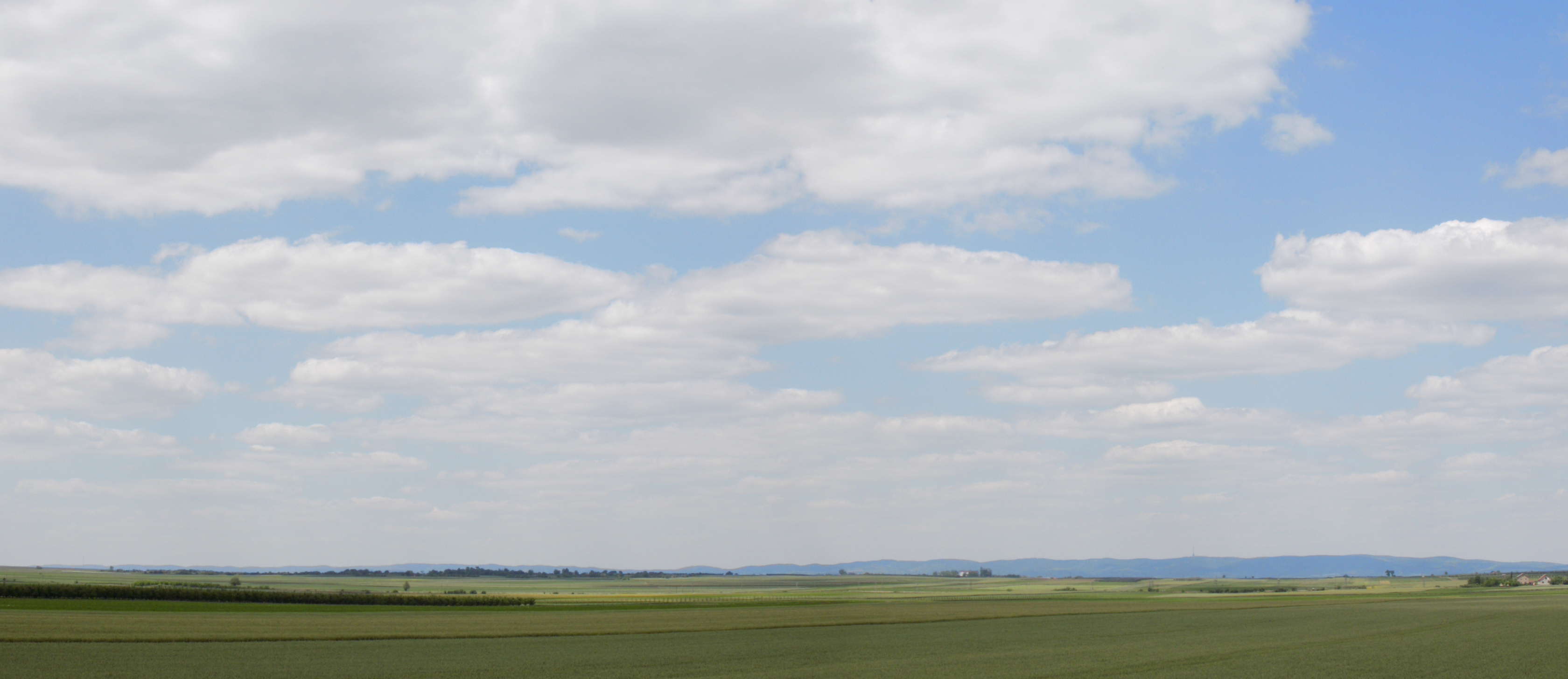
So, the gravel road leads to village Dobrinci (Добринци) where it turns into a paved street and soon I reached the crossroad with one of the main roads and this is the place where the Church of St. Nicholas is located. This church is categorised as the immobile cultural property of great importance.
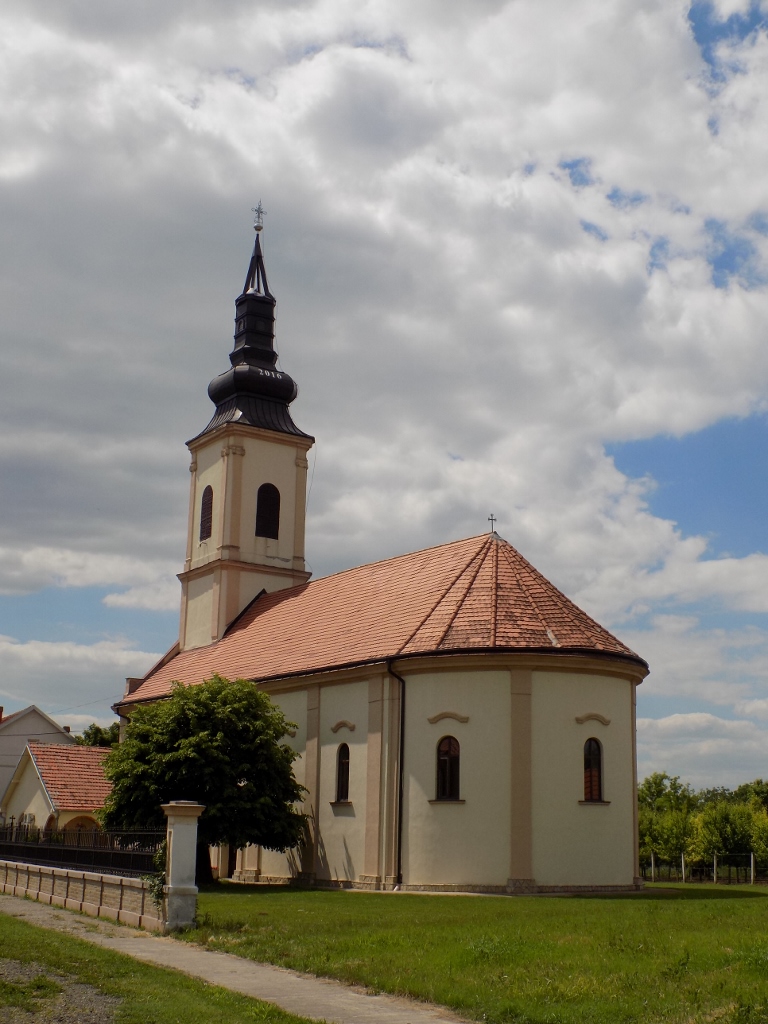 Church of St. Nicholas, Dobrinci
Church of St. Nicholas, Dobrinci
The church was built in the first half of the 19th century and it is quite typical of Vojvodina’s temples from that period – a single-nave edifice with a semi-circular apse on the east side and a bell tower above the west part of the church. In the interior, there are paintings from 1831, while parts of the old iconostasis in combination with woodcarving and icons from the 19th century constitute the iconostasis that is seen today. Still, I did not see this personally, since the church was closed. So I just made a circle around it, taking a photo of its front facade where there is a depiction of St. Nicholas above the entrance.
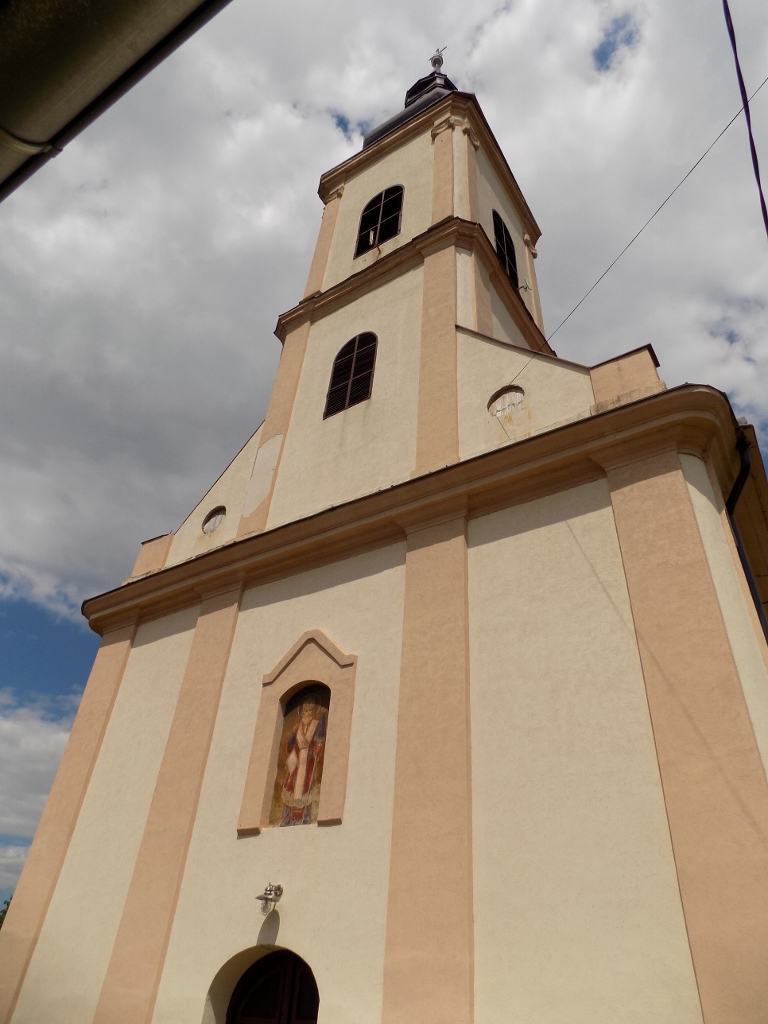 Front facade and the bell tower of the church of St. Nicholas, Dobrinci
Front facade and the bell tower of the church of St. Nicholas, Dobrinci
In Dobrinci, too, there is another important place and this is the archaeological site Solnok the original name of which is Caput Bassianense. This is where remains of the ancient Roman fortification from the 2nd century CE were found, including also remains of buildings and graves. This site could also not be seen in reality, although it is not by the road either, but rather somewhere farther away under the fields covered in crops and it has been established that these remains cover the area of 30 hectares.
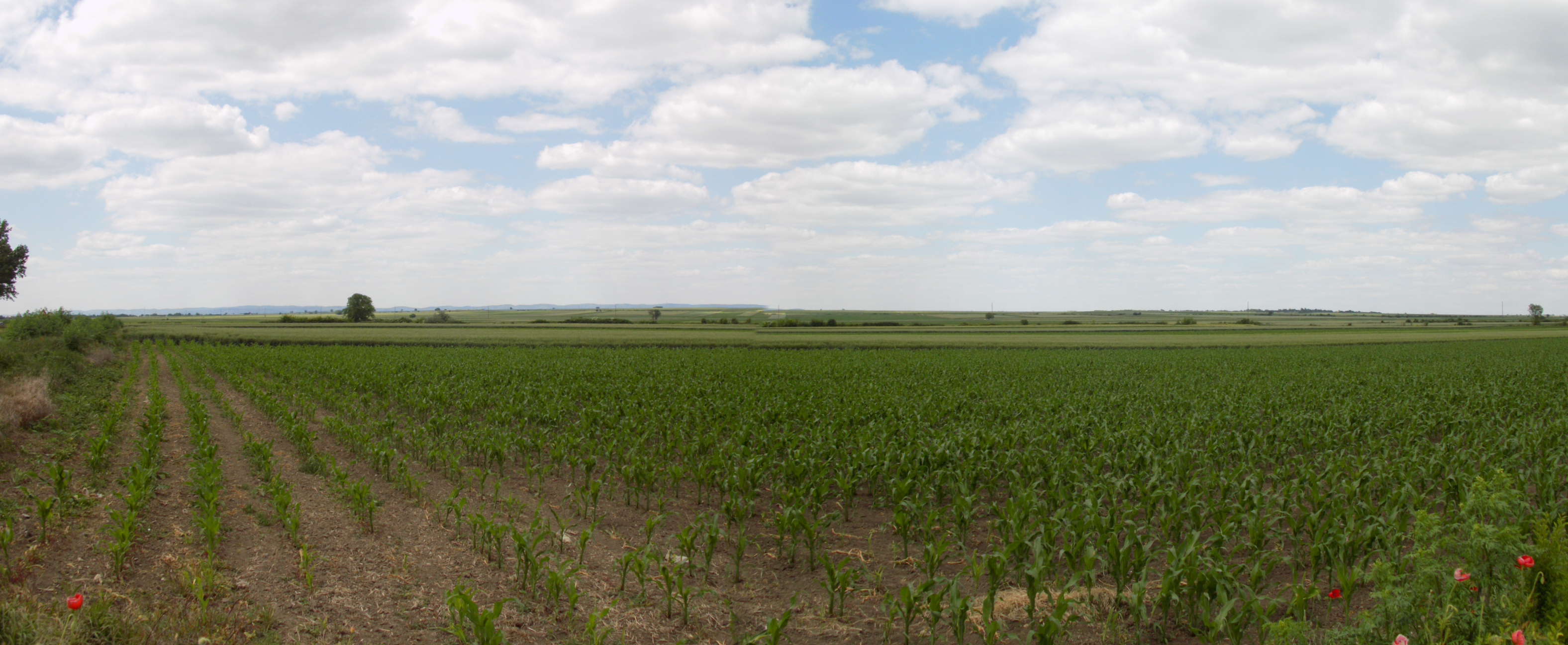
By the way, it was precisely this military fortification in which the II legion Adiutrix was stationed that served to secure the town of Bassianae some 4-5 km further to the east.
Following the main road now, soon I got to village Kraljevci (Краљевци) in the centre of which there is the Church of St. Nicholas that is also an immobile cultural property of great importance.
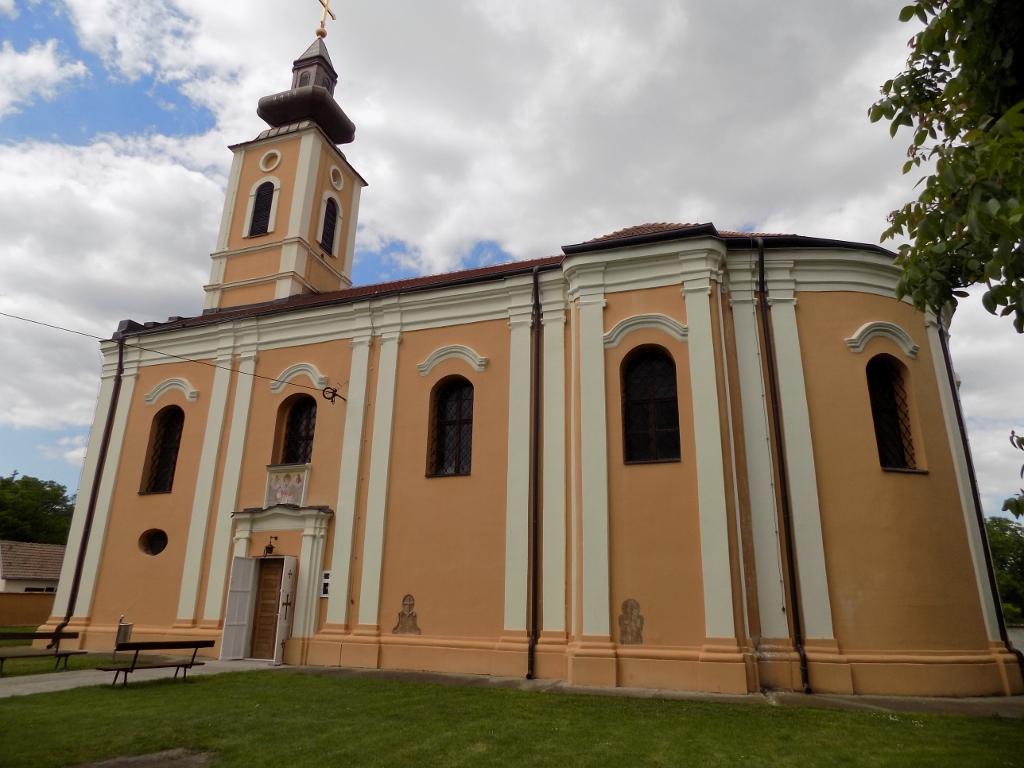 Church of St. Nicholas, Kraljevci
Church of St. Nicholas, Kraljevci
The church was built in the second half of the 18th century. It also reflects the style of its epoch and what I found noticeable in comparison to the churches previously seen during this trip is that from the outside one can easily discern the slightly protruding space of the choirs. Here I had a lot of luck that the priest was still there, so in addition to entering the church and looking at its interior, I also talked with him a little.
To start with, as usual, the most striking element of the interior is the iconostasis.
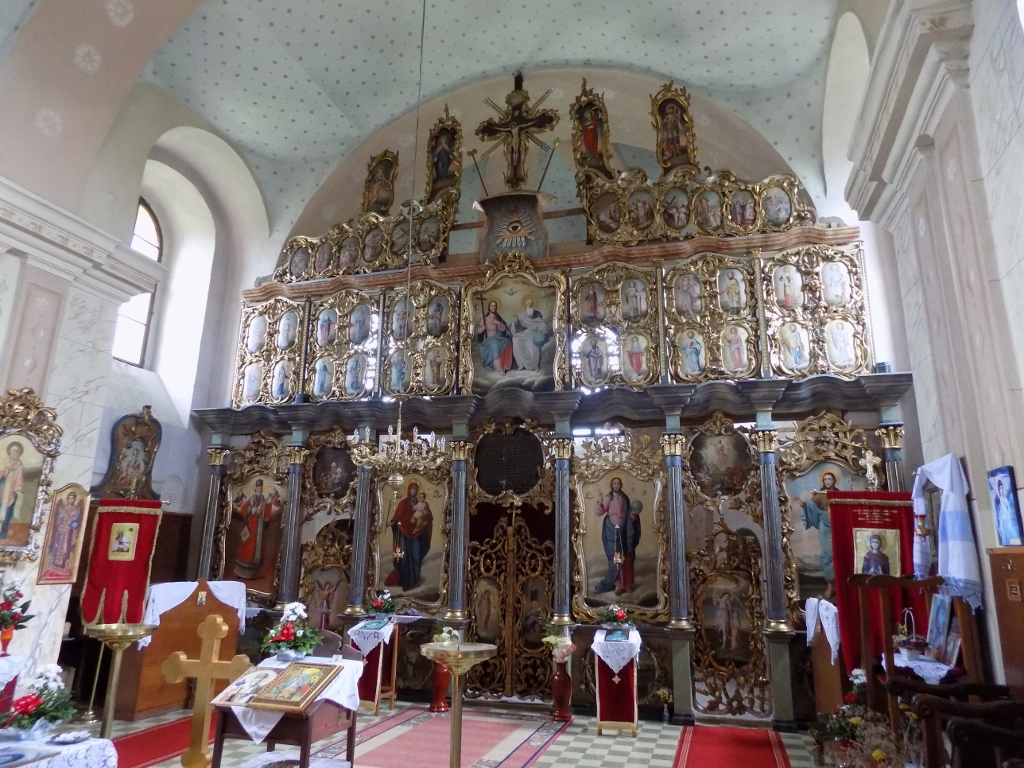 Iconostasis of the Church of St. Nicholas, Kraljevci
Iconostasis of the Church of St. Nicholas, Kraljevci
Even I have heard of the painter who did the icons, almost 60 of them, from 1792 to 1794. This was Jakov Orfelin (mid-18th century-1803), a Serbian Baroque painter. Admittedly, those in the know say that he did not excel here in Kraljevci, but it is certainly interesting to come here and personally see his work.
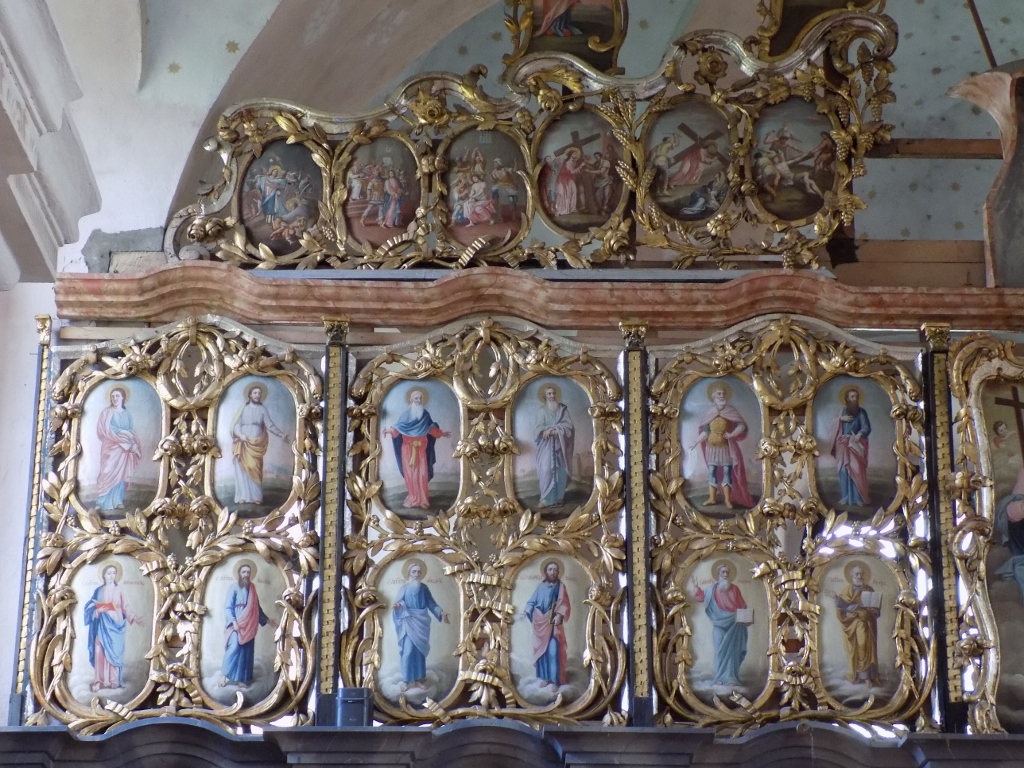 Part of the iconostasis of the Church of St. Nicholas, Kraljevci
Part of the iconostasis of the Church of St. Nicholas, Kraljevci
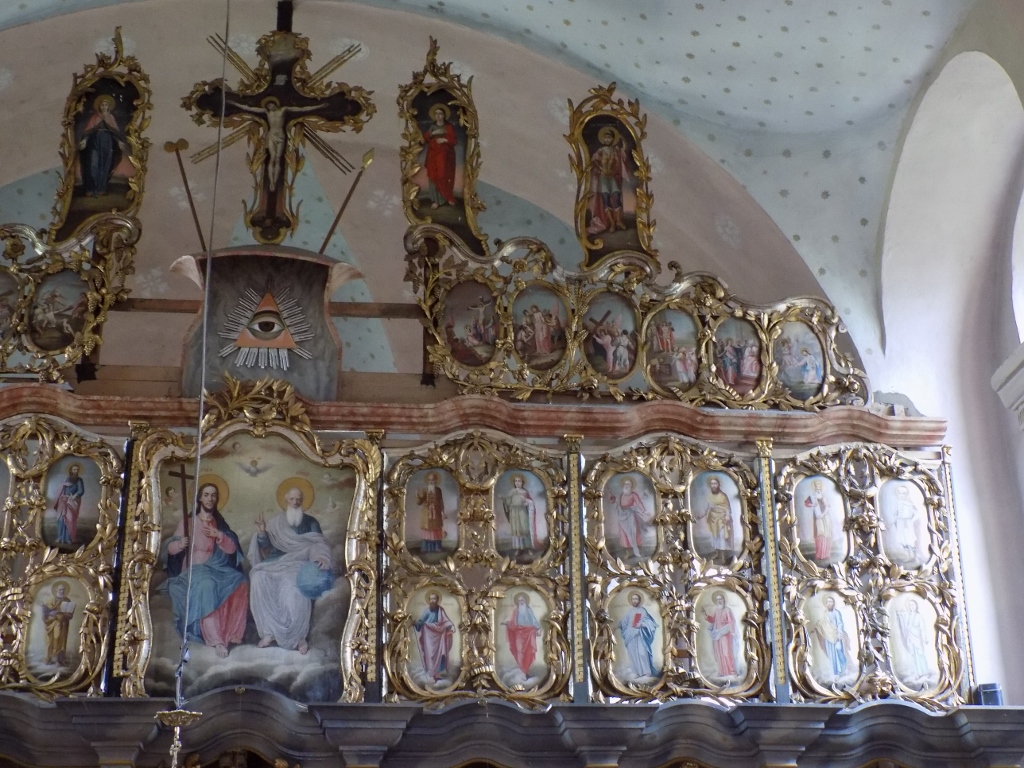 Part of the iconostasis of the Church of St. Nicholas, Kraljevci
Part of the iconostasis of the Church of St. Nicholas, Kraljevci
On the other hand, it is interesting that the church was significantly damaged during WWII and so the icons were temporarily kept at the Gallery of the Matica Srpska in Novi Sad. The reconstruction started only around 1971 and after that Orfelin’s paintings were brought back to the iconostasis. It was the priest who told me about this, but there is also a commemorating plaque which says that a resident of Kraljevci who immigrated to the USA in 1948 gave donation for the restoration of the church in the amount of 10,000 USD (when judging this, take into account the inflation).
Thanking the priest for the conversation, I went on, looking for another interesting place. This was an archaeological site from prehistory or rather the Big Mound-Tumulus (Velika humka-tumul). This site is also located in the middle of agricultural land, more accurately in a private plot of land, so I first looked into how to get to those fields that are situated behind the private houses in the village. I did find a dirt road and so I reached the fields, but that was it. Since this concerns a mild elevation, a mound, I decided to declare that the mild elevation with trees seen in the photo below was the Big Mound-Tumulus. It is quite probable that I was completely wrong, but this actually has no bearing. After all, it just serves as a suitable illustration.
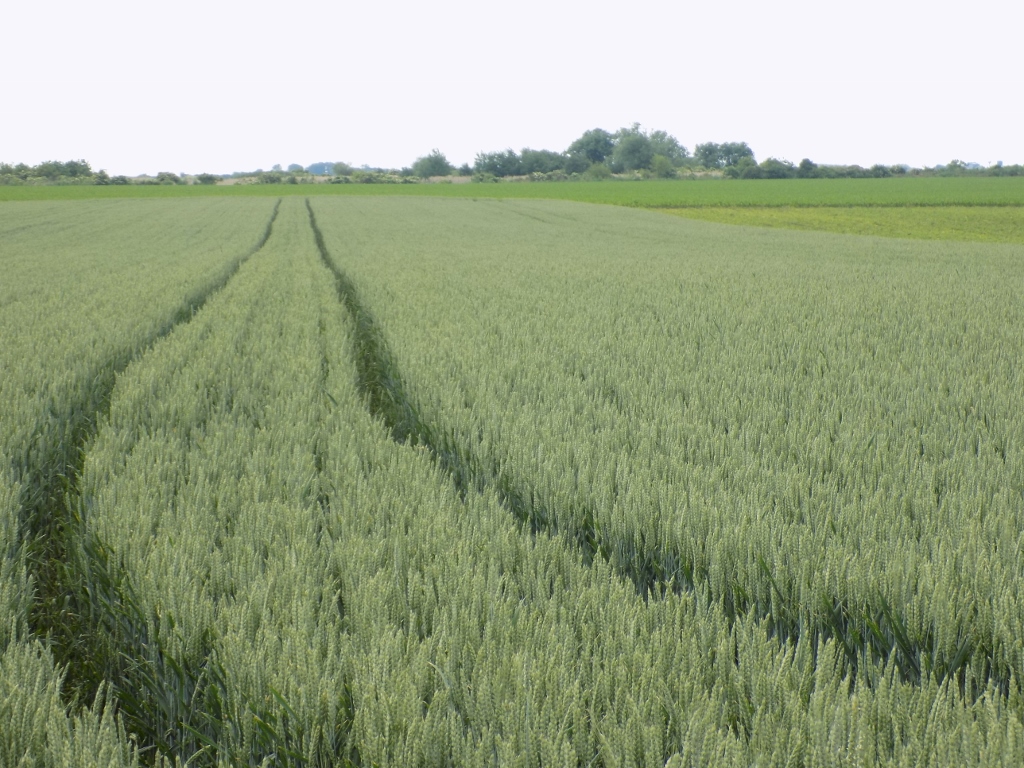 The alleged Big Mound-Tumulus
The alleged Big Mound-Tumulus
Tumulus is the name for an artificial elevation, a mound in other words, most often of a circular shape that was used in prehistory for burial either as an individual tomb or a necropolis. Tumuli were often used for the same purpose later on. In all of Syrmia and also in the wider region there are numerous tumuli. What is interesting in connection with this particular tumulus is the belief preserved here in the village that the mound was created when Prince Marko (legendary Serbian medieval hero) cleaned off dirt from his shoes.
So, here I decided to finish with my sightseeing for the day although it was still early afternoon. I simply got into the car and drove to the hotel in which I had booked a room. This is a small hotel north of Ruma that has a “spa centre” and that has been highly recommended to me. That’s why right after getting the room I went to the spa where I stayed for a couple of hours. After dinner I also went for a short walk to the nearby artificial Borkovačko Lake often referred to simply as Borkovac.
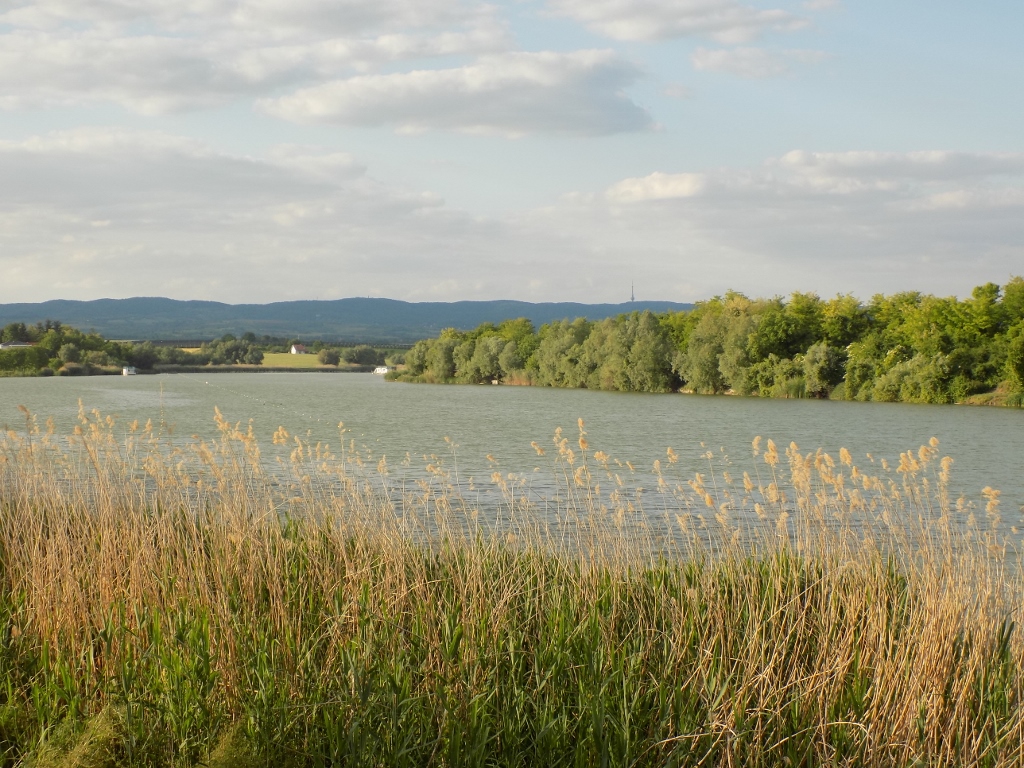 Borkovačko Lake
Borkovačko Lake
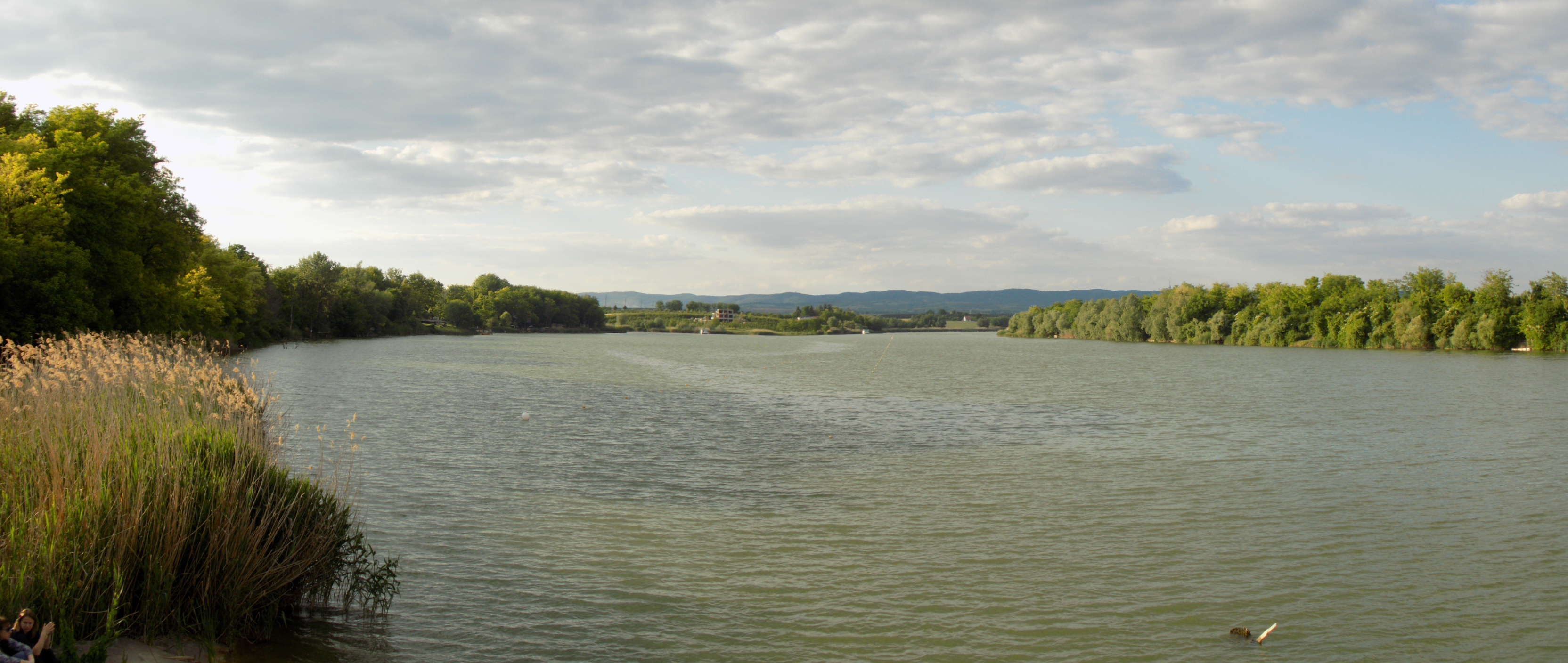
Borkovačko Lake is an artificial reservoir made here some 40 years ago and it is mostly used by anglers, although it is also possible to swim here in summer. I was not interested in any of these activities, but I truly enjoyed the quiet twilight.
I went to bed rather early that evening and so I woke up rather early the next morning. And the day was perfect: not a single cloud in the sky and it felt pleasantly fresh. I went down to the hotel’s terrace that overlooked a wonderful dense forest and I had a coffee there. Everything seemed perfect except for... Although discreetly, all the time there was some music coming from speakers, while on the other side, in the forest, there was a serious concert of numerous birds going on. I don’t know why humans have such a need for different “going-ons” that are so often distractions to my mind. They seem not to be able to sit and look at something around them in peace, no, they have to look at their devices. They cannot listen to the natural sounds around them and feel the need for some human music creations filling up the space, although most often they are not aware even of that... Well, these were the thoughts that were getting around my head this early morning while I was sitting on that terrace. So, I made sure I had my coffee comparatively quickly and then I went down a nearby slope in order to get to the forest and be alone in that blissfulness created by the natural sounds. It was the time for a nice morning walk. You will be able to see the photos, but you can only try to imagine the sound of the birds on this occasion. And it was wonderful.
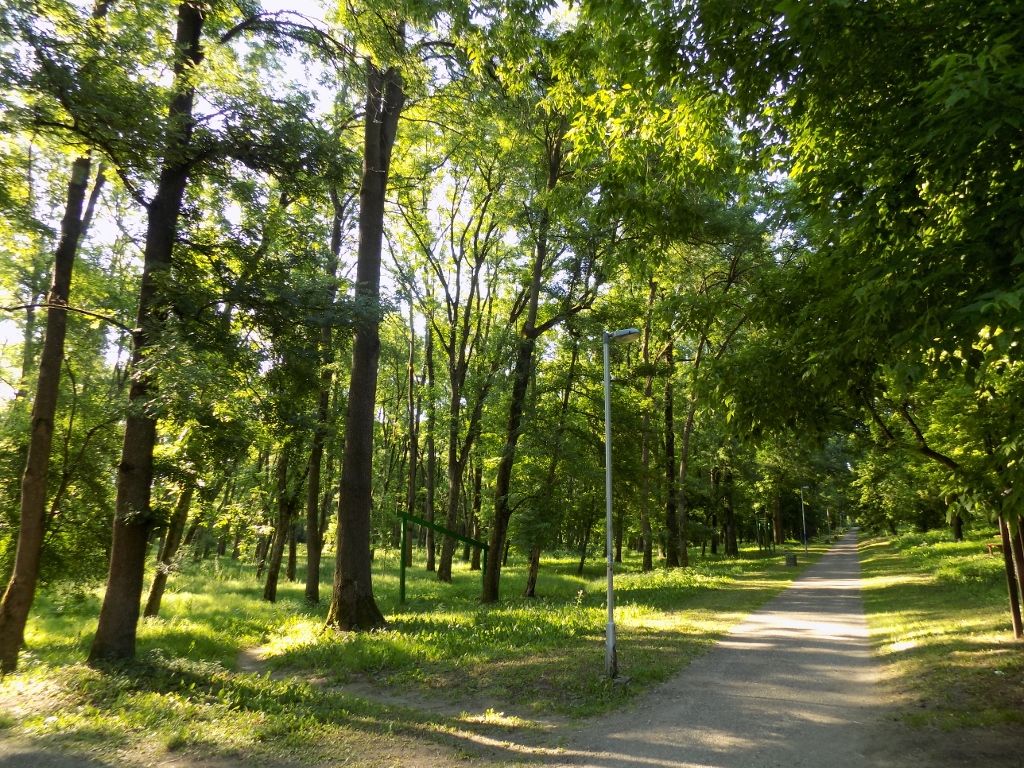 Forest near Borkovačko Lake
Forest near Borkovačko Lake
Within the forest by Borkovačko Lake there are proper paved walking paths and there are also natural paths created by regular human passage.
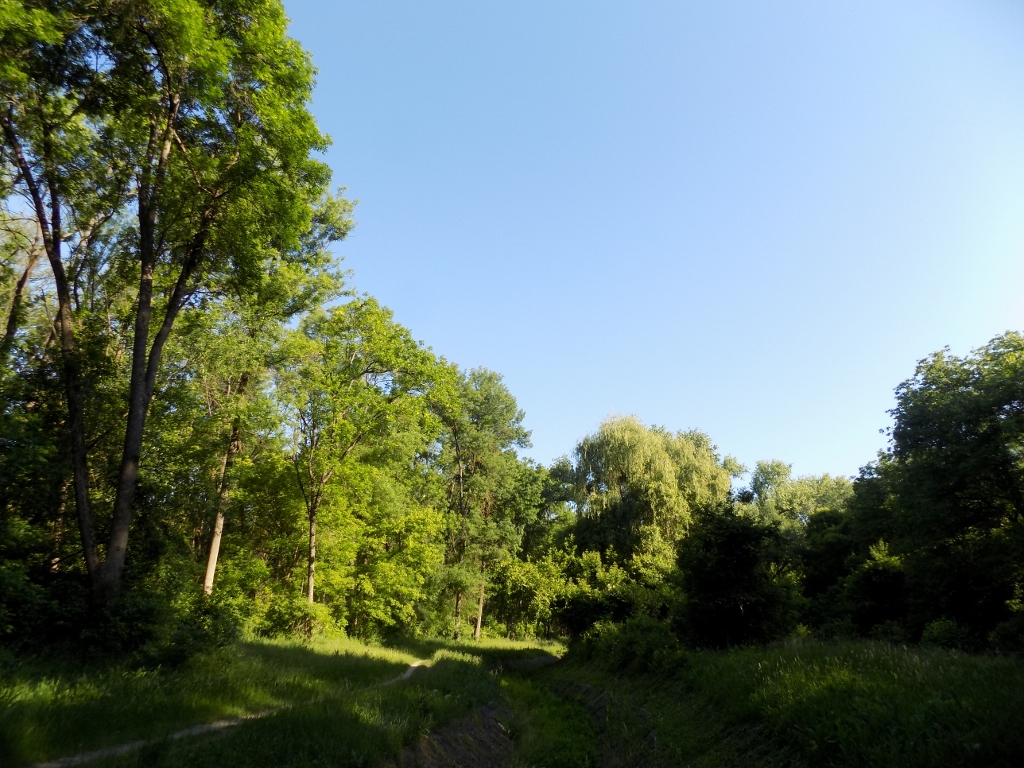 Forest near Borkovačko Lake
Forest near Borkovačko Lake
This is in fact a small forest that is quite dense in some parts and with very tall trees, while through another part runs a canal that takes the water away from Borkovačko Lake and therefore there is more space between trees in this section. Walking along an informal path I was delighted when I came across a “tree bouquet.”
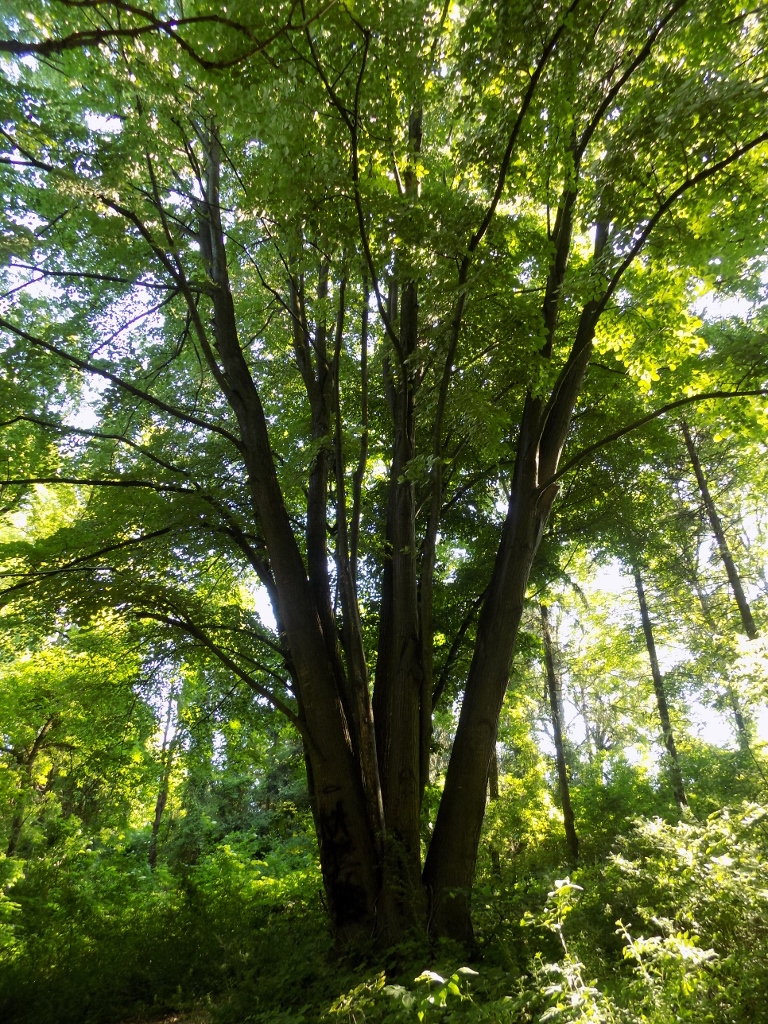 Tree bouquet
Tree bouquet
Then I got out of the forest and started to follow a dirt road that runs along the east side of the lake. By the way, in this entire area these dirt roads are also used as bicycle paths and there are bicycle guideposts. Bicycles may be even rented at the hotel I was staying at, but in places like this I prefer to walk.
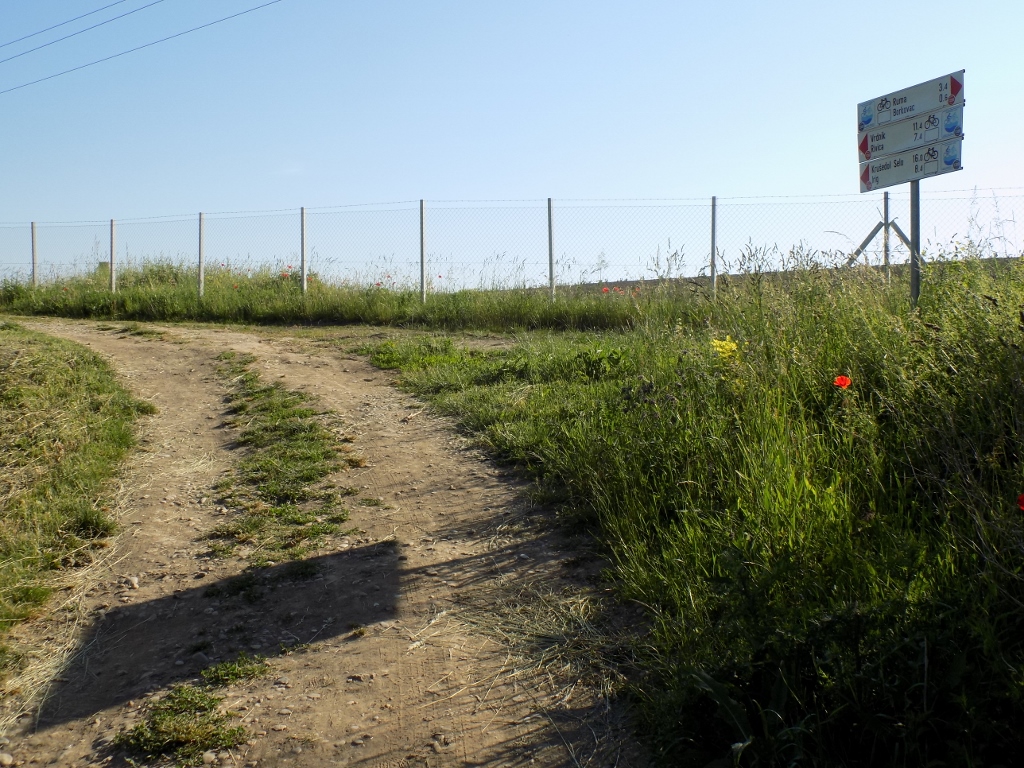 Dirt road/bicycle path/walking path
Dirt road/bicycle path/walking path
Relatively early in the morning the lake was wonderfully peaceful. In addition to me, the beauty of the calm lake was also enjoyed by a Eurasian coot (Fulica atra).
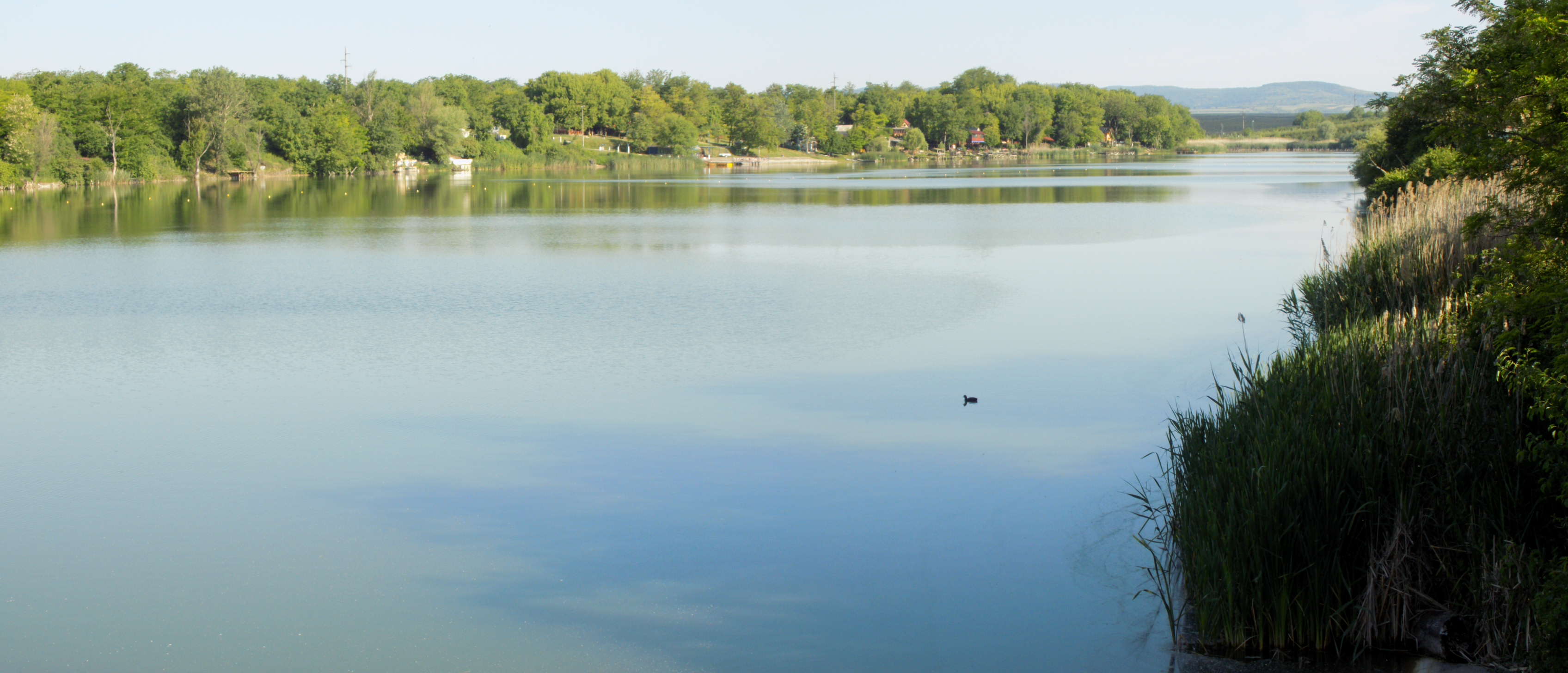
It became clear what it was doing there this early in the morning soon enough: it was on a fact-finding mission, since she was about to take her offspring for a “walk” on the lake.
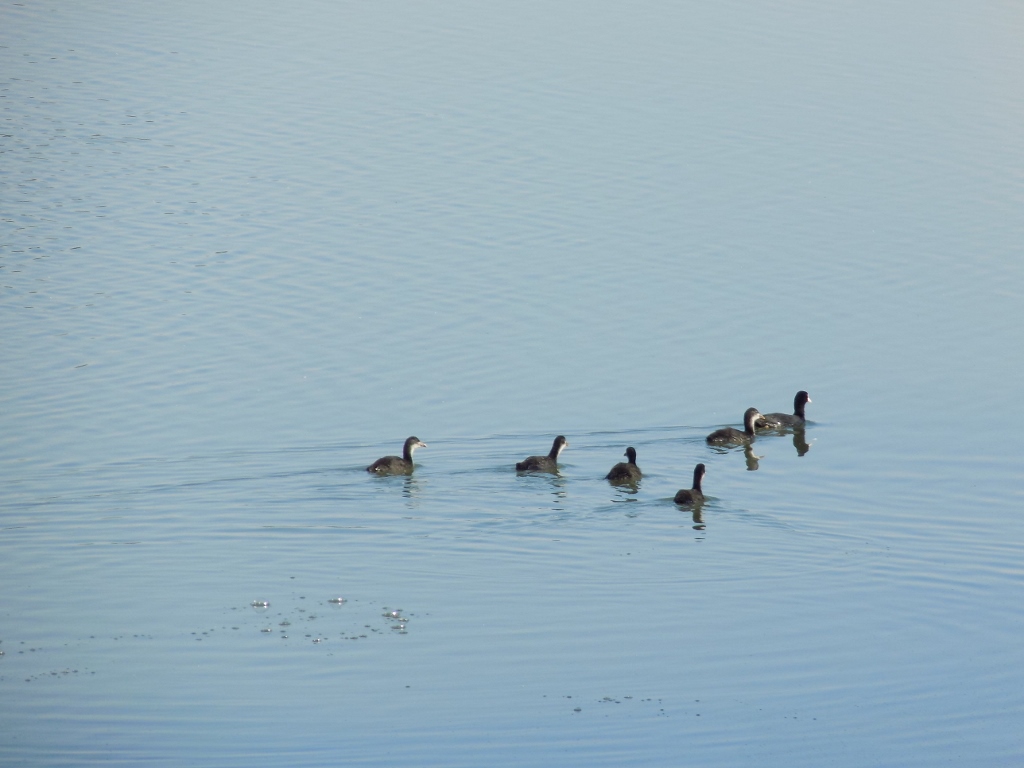 The Eurasian coot and her children
The Eurasian coot and her children
I continued with my walk and soon came across a gorgeous sight with field poppies.
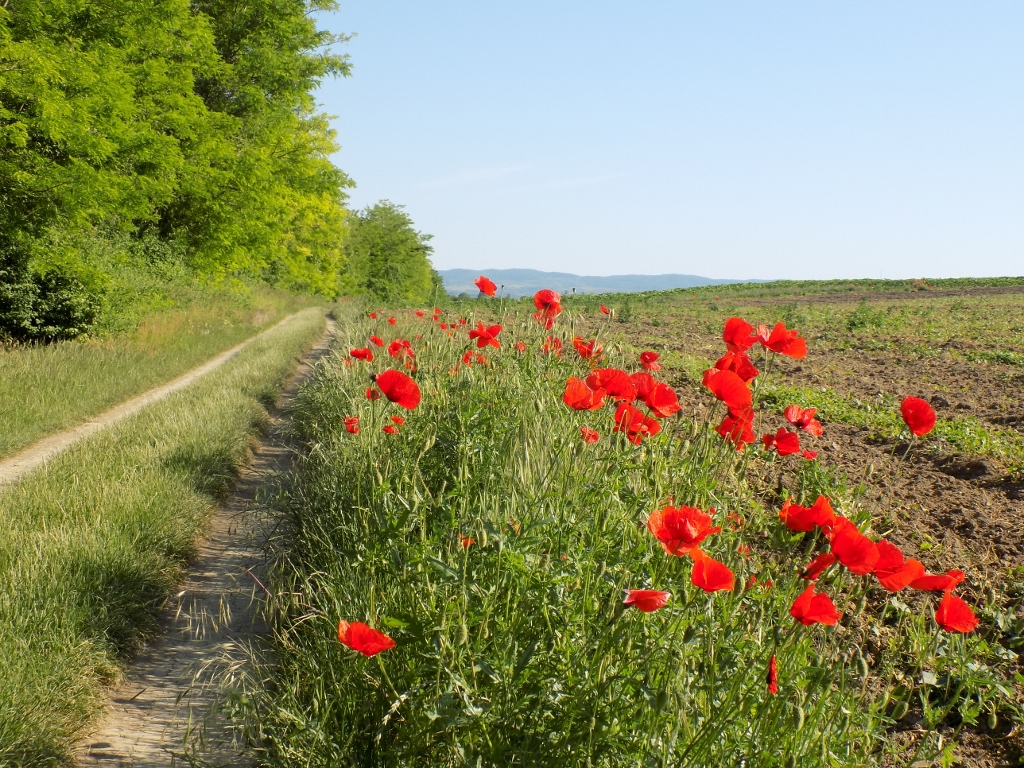 Field poppies near Borkovačko Lake
Field poppies near Borkovačko Lake
On the other side of the lake, between the trees, I could see some houses lit by the morning sun.
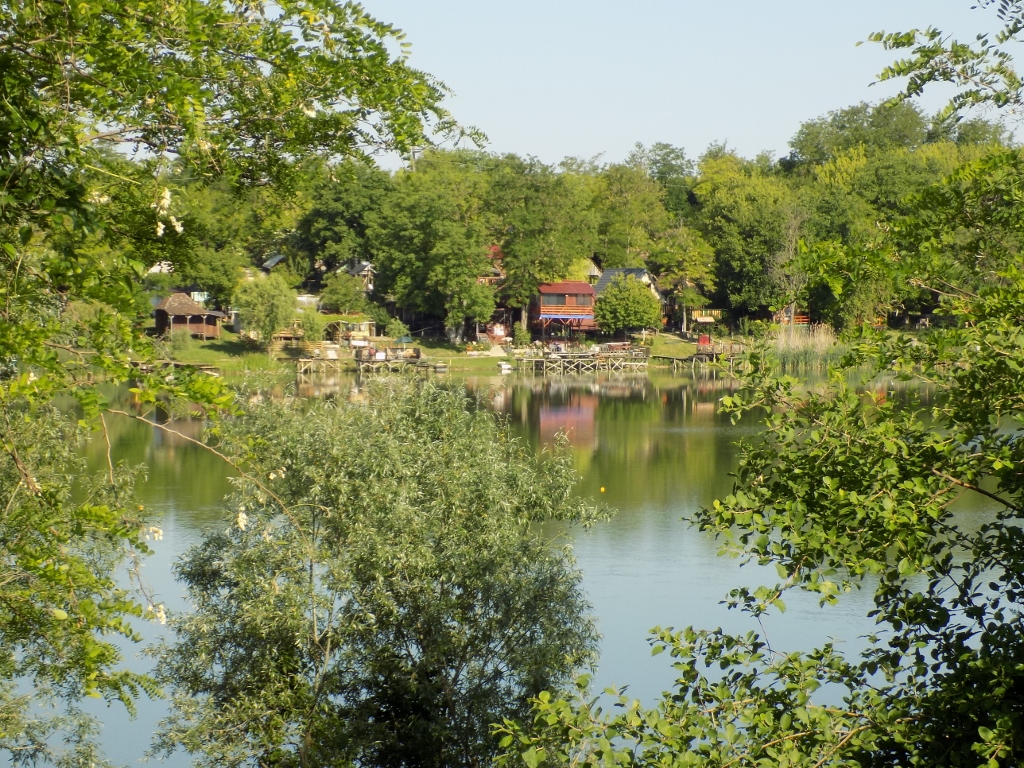 Houses on the shore of Borkovačko Lake
Houses on the shore of Borkovačko Lake
However, as opposed to the peaceful morning in human homes on the west side of the lake, on this side where I was walking the life was going on quite actively and I served as a witness. So, I came across a beautiful butterfly. It was a painted lady (Vanessa cardui).
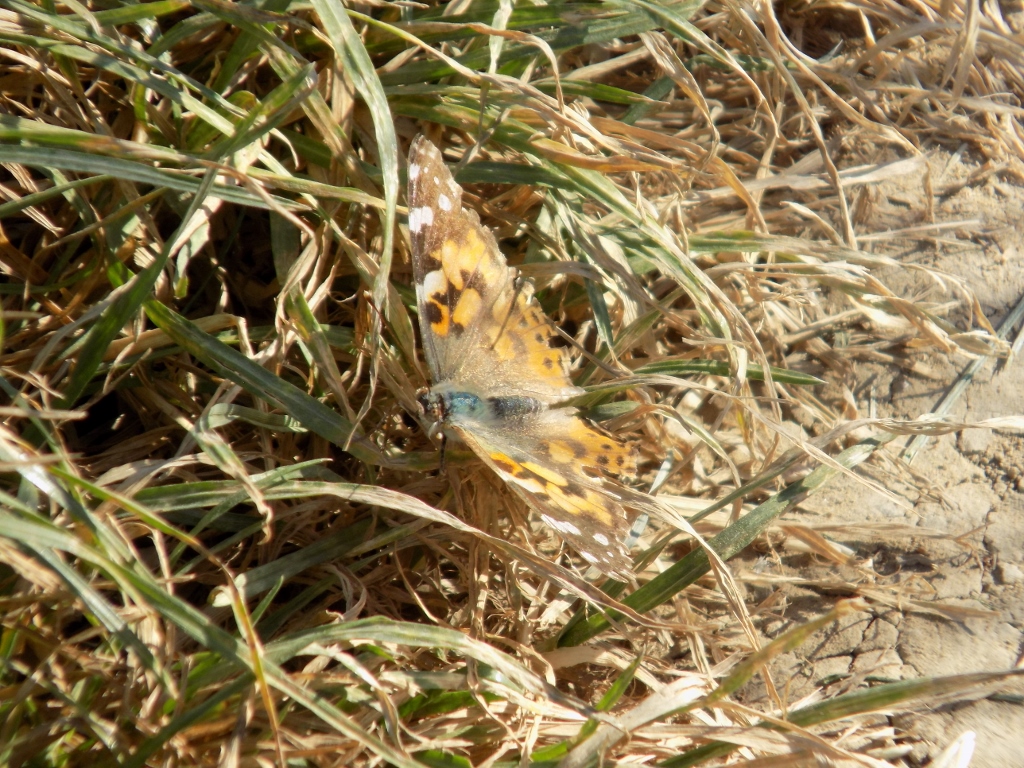 Painted lady
Painted lady
Then I also came across some dragonflies. They were the black-tailed skimmer (Orthetrum cancellatum), which I learned later on.
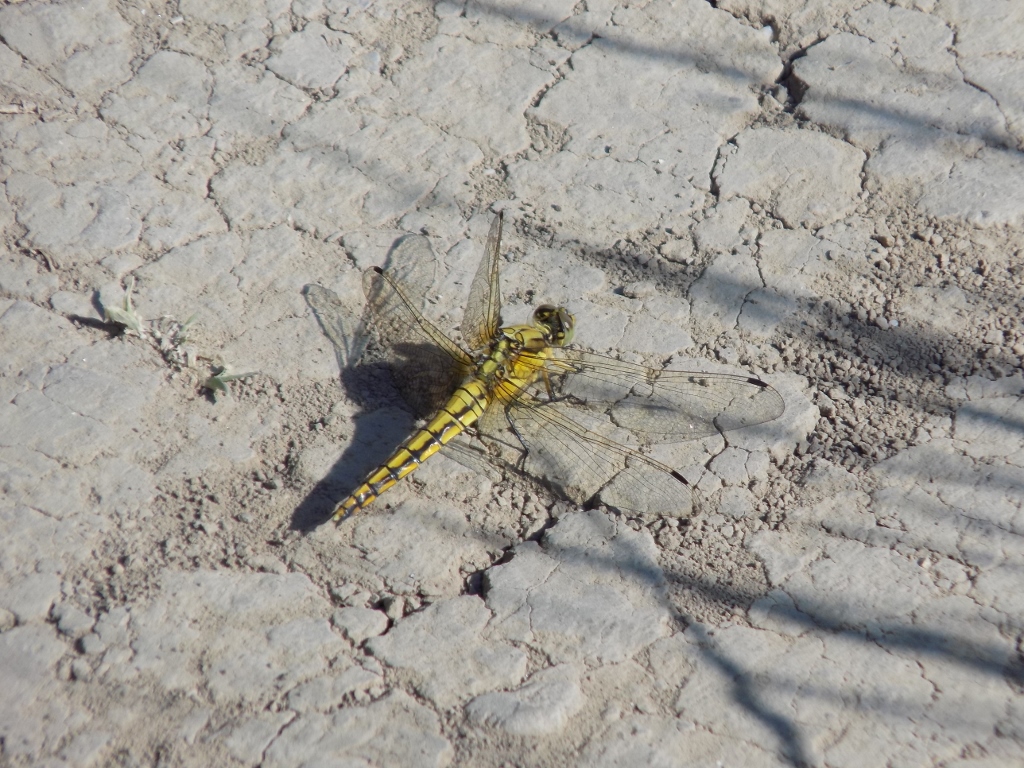 Black-tailed skimmer
Black-tailed skimmer
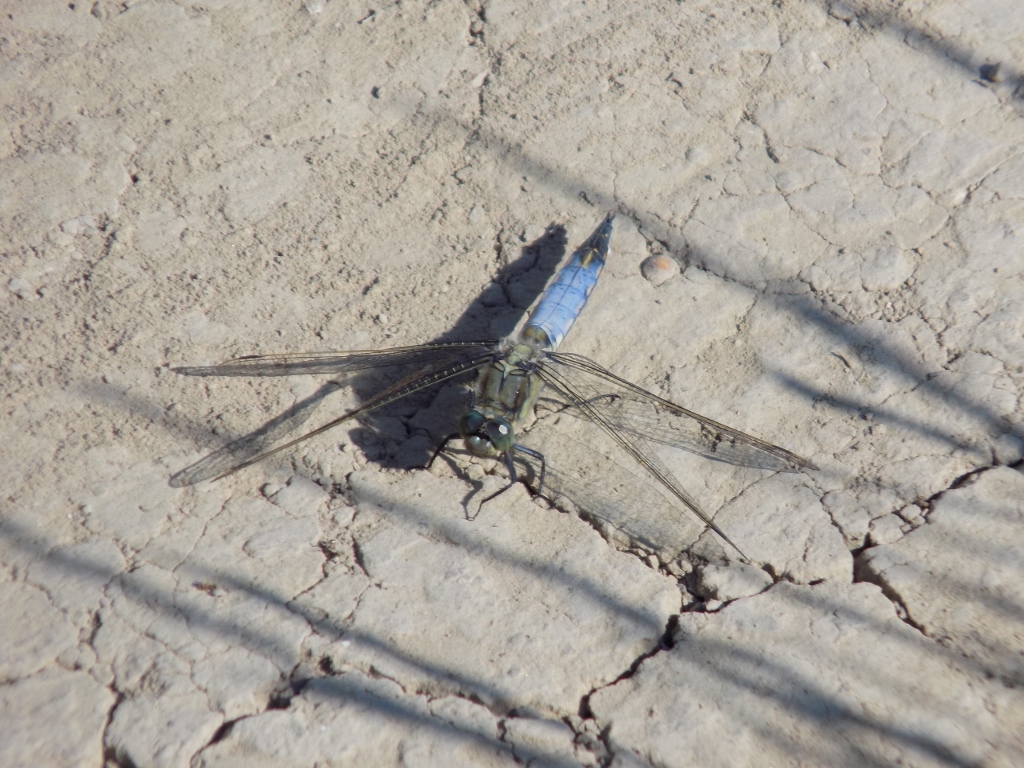 Black-tailed skimmer
Black-tailed skimmer
When I saw them, I was not sure whether this was the same species or not. As it turned out it was, but this is the case of sexual dimorphism (different colours with males and females). This became quite clear soon enough for I took photos of them while they were mating and on that occasion they flew up and down several times without parting for a second. Well, that’s what I call love!
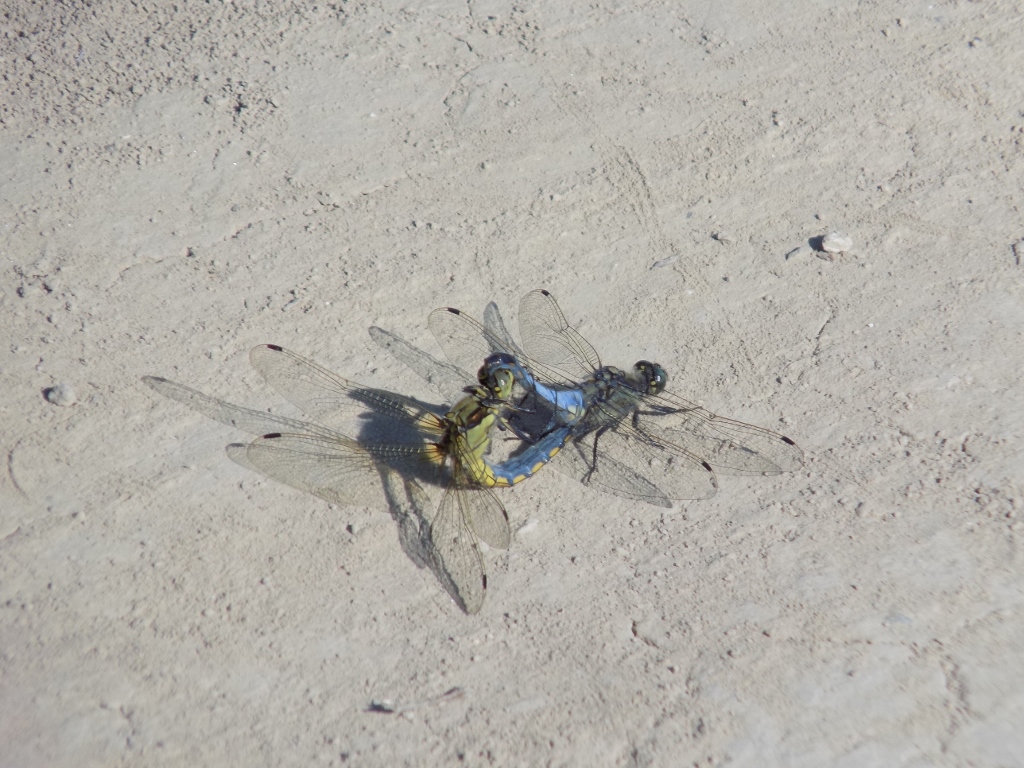 A couple of black-tailed skimmers are mating
A couple of black-tailed skimmers are mating
On the east side of the lake there are also smaller plots of land with small houses on them and more or less developed property. So, in one place I came across a nicely shaped elder tree (Sambucus nigra) that I usually see growing in the shape of a large shrub.
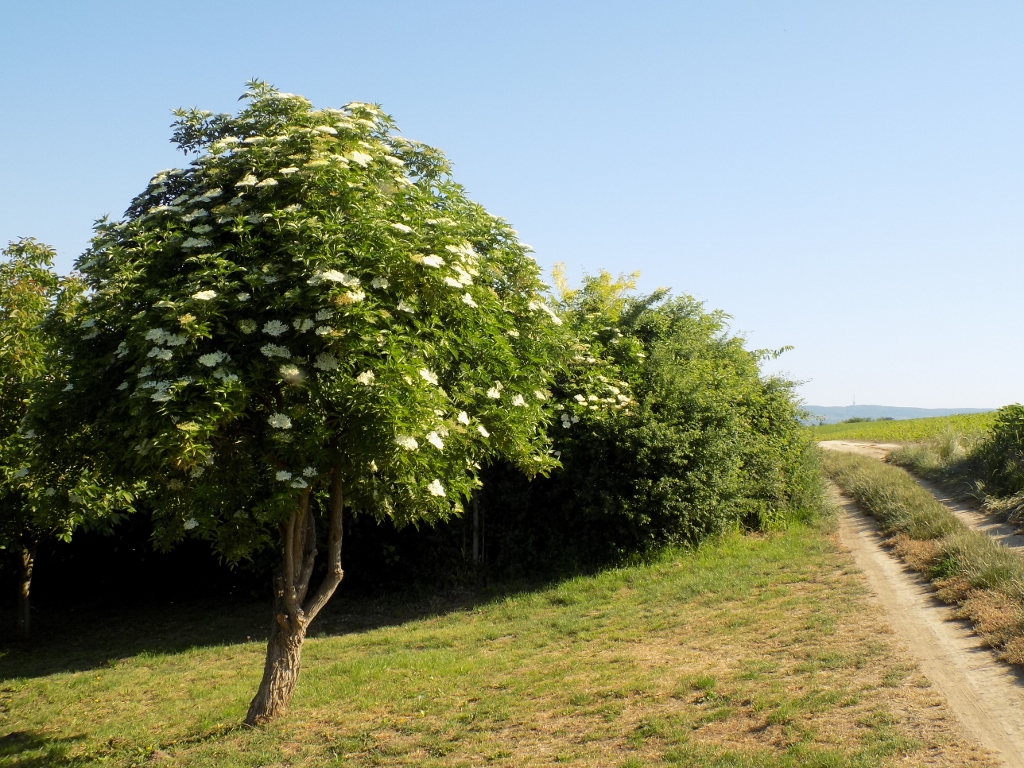 Elder tree
Elder tree
Still there were areas with no houses in sight, although everything here is mostly “urbanised in a rural way.”
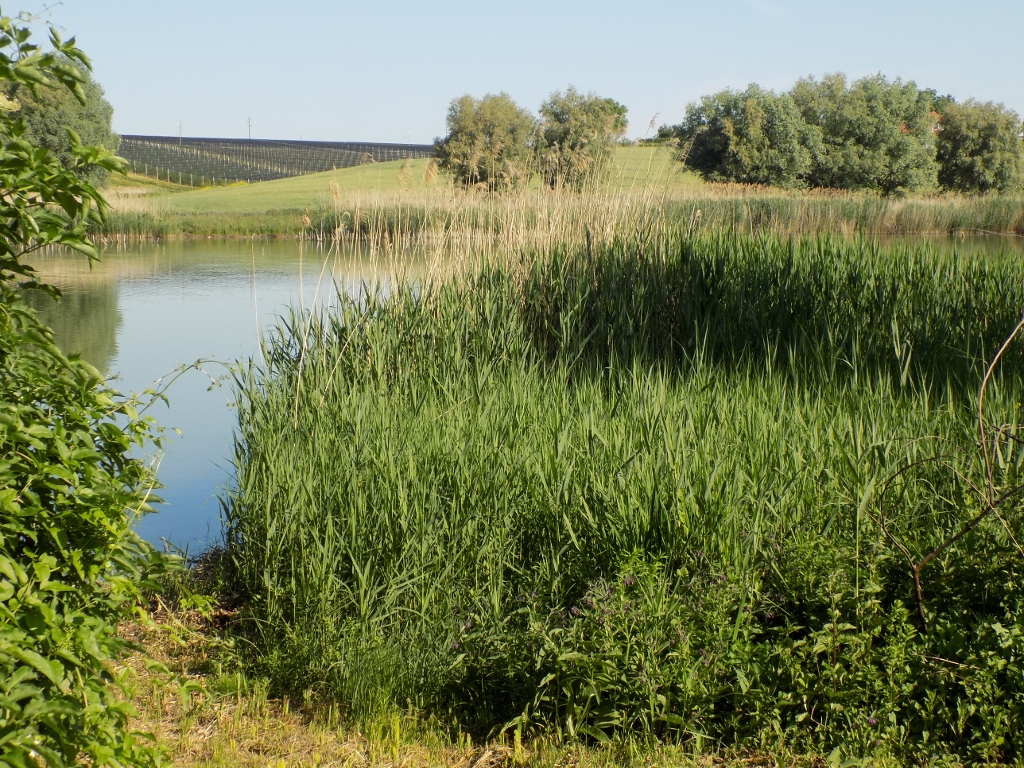 Borkovačko Lake and its surroundings
Borkovačko Lake and its surroundings
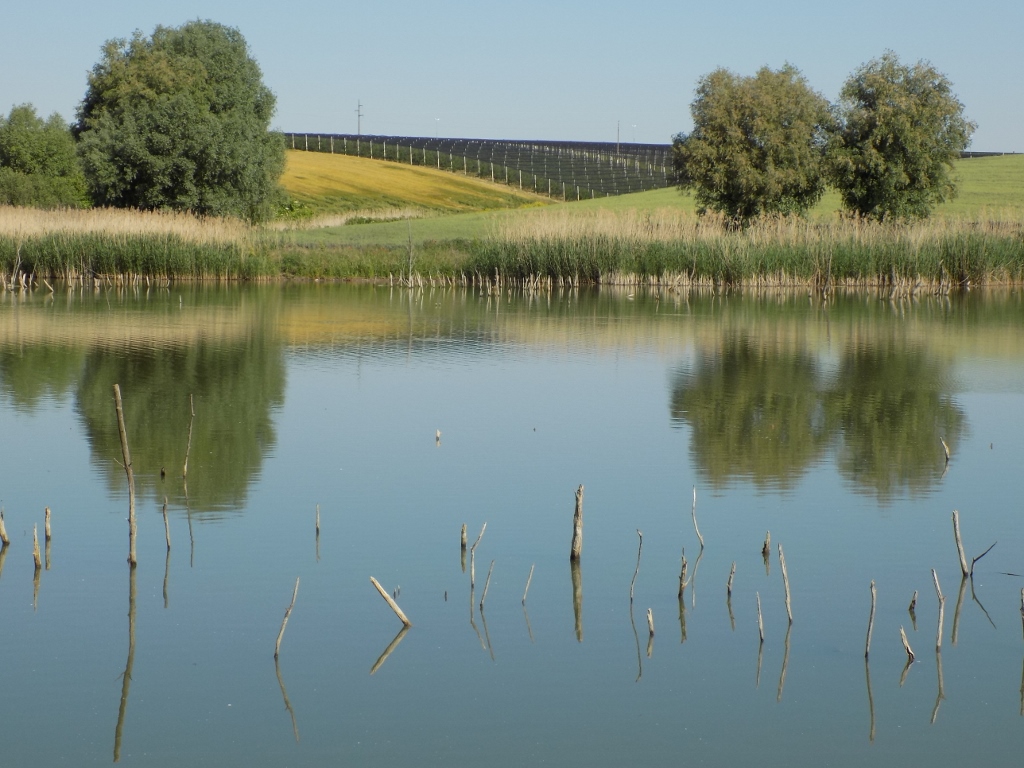 Borkovačko Lake and its surroundings
Borkovačko Lake and its surroundings
Needless to say, there were field poppies again.
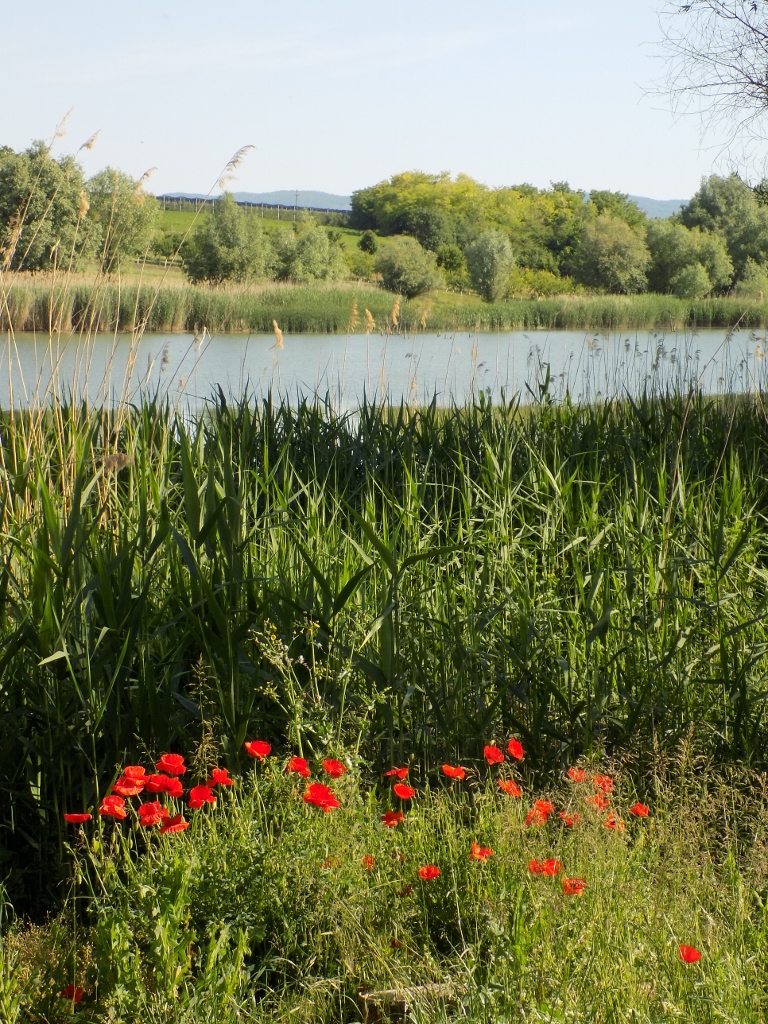 Field poppies
Field poppies
I also came across an angler/early bird. Although I’m not into fishing, I can totally relate to this hobby – it’s something like a meditation or an anti-stress therapy in nature.
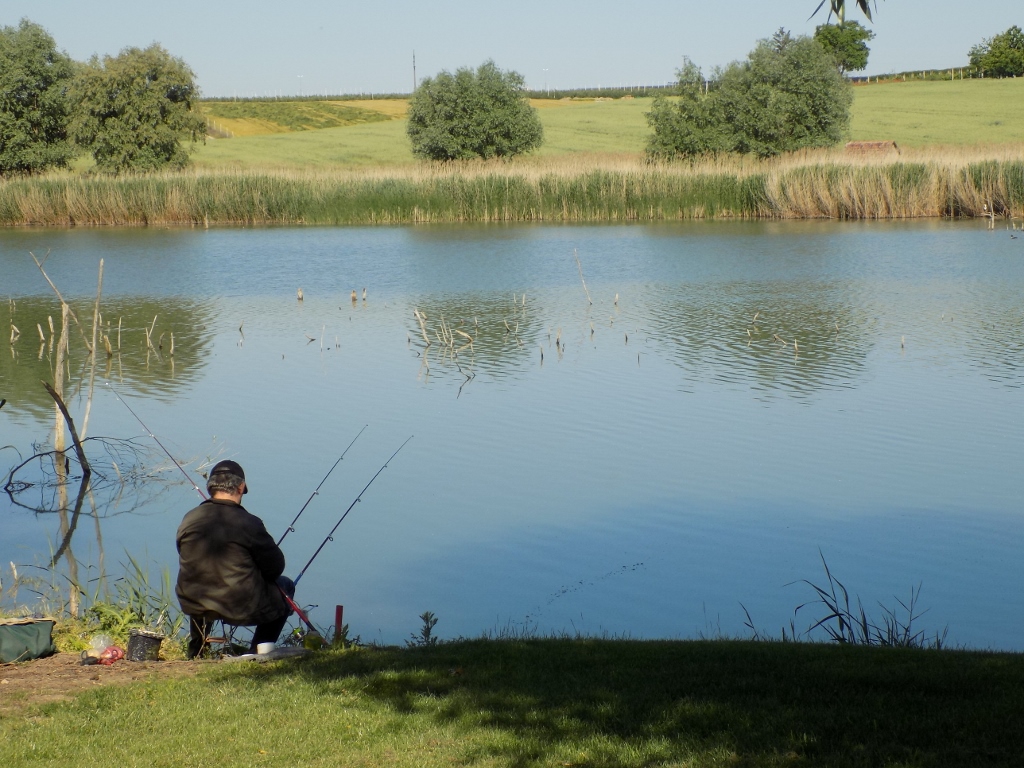 Borkovačko Lake and its surroundings
Borkovačko Lake and its surroundings
And then I passed by a house where I saw beehives. Going forward along the path, just some 5-6 metres farther I heard very loud humming. Still, I went on boldly thinking that bees are not predators in fact and they do not attack people, they only defend themselves. So, I walked at a moderate, but uniformed pace and it all went well. Then I looked back and up. I could not believe how many bees there were! I presume that the main reason for this bee “frenzy” was the blossoming black locust tree (Robinia pseudoacacia).
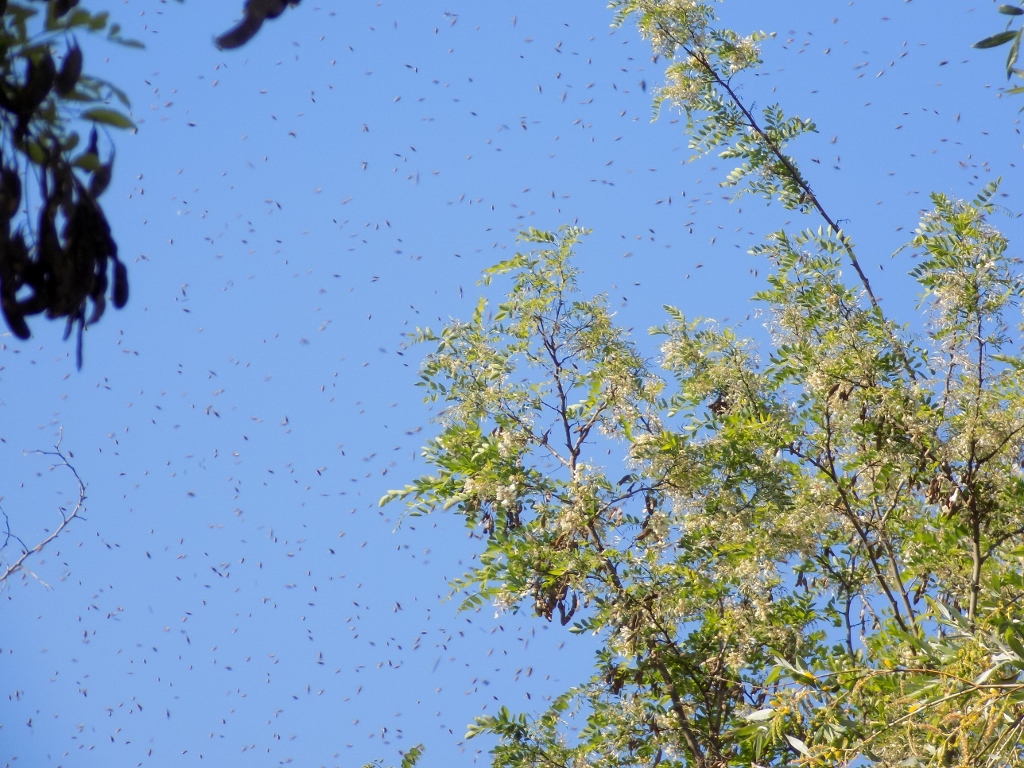 The bees and the black locust
The bees and the black locust
Not far from there I also saw a swan.
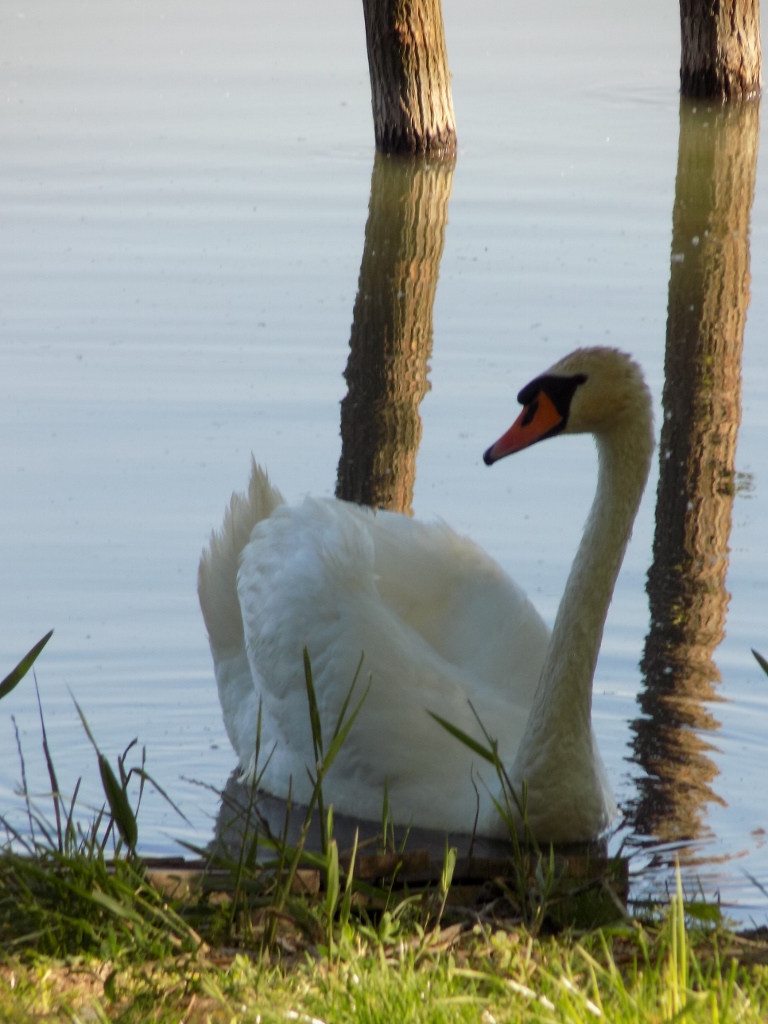 Swan on Borkovačko Lake
Swan on Borkovačko Lake
These are such gracious birds, but only provided they are in the water! The minute they get out on the shore they lose all their graciousness. This one came out in order to graze, but I have decided not to post its photos where it greedily plucked grass in order not to embarrass it. So, instead, here is one where it’s looking at me in a suspicious manner trying to guess what I was up to.
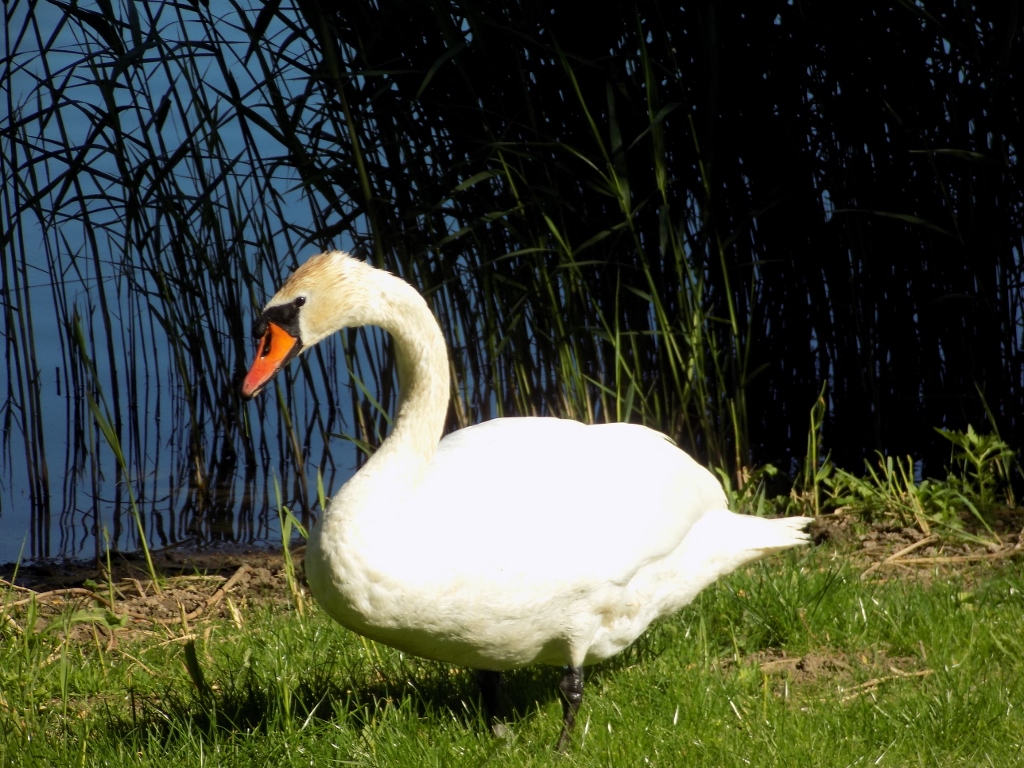 Swan on the shore of Borkovačko Lake
Swan on the shore of Borkovačko Lake
A little farther away I saw probably the wife of the swan from the shore and it was clear that while he was stuffing himself with grass, she was taking care of the offspring.
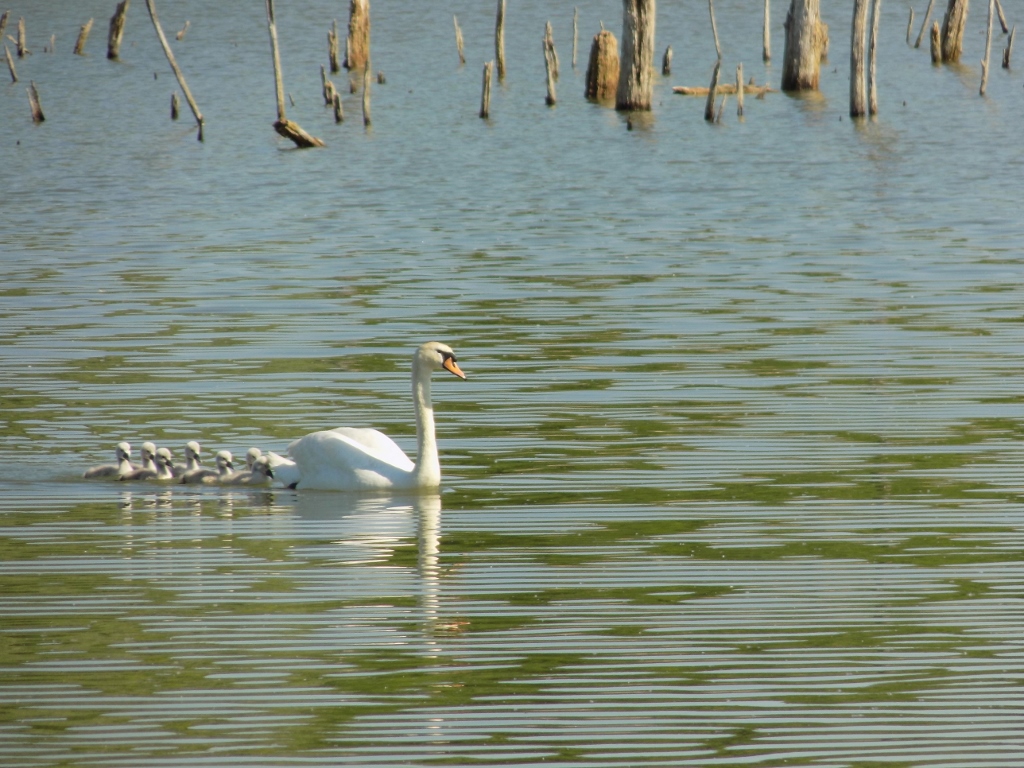 Swan with “ugly ducklings”
Swan with “ugly ducklings”
Following the walking path it became clear to me at some point that I had walked past the lake, but there was no place where I could see any turn that would lead to the other side, while I was convinced there must be a circular path around the lake. Then, at some point I saw something that looked like a dirt road, rather covered in grass, leading in the direction I wanted, so I headed that way. Very soon I came across a property and there I first saw a most interesting “settlement.”
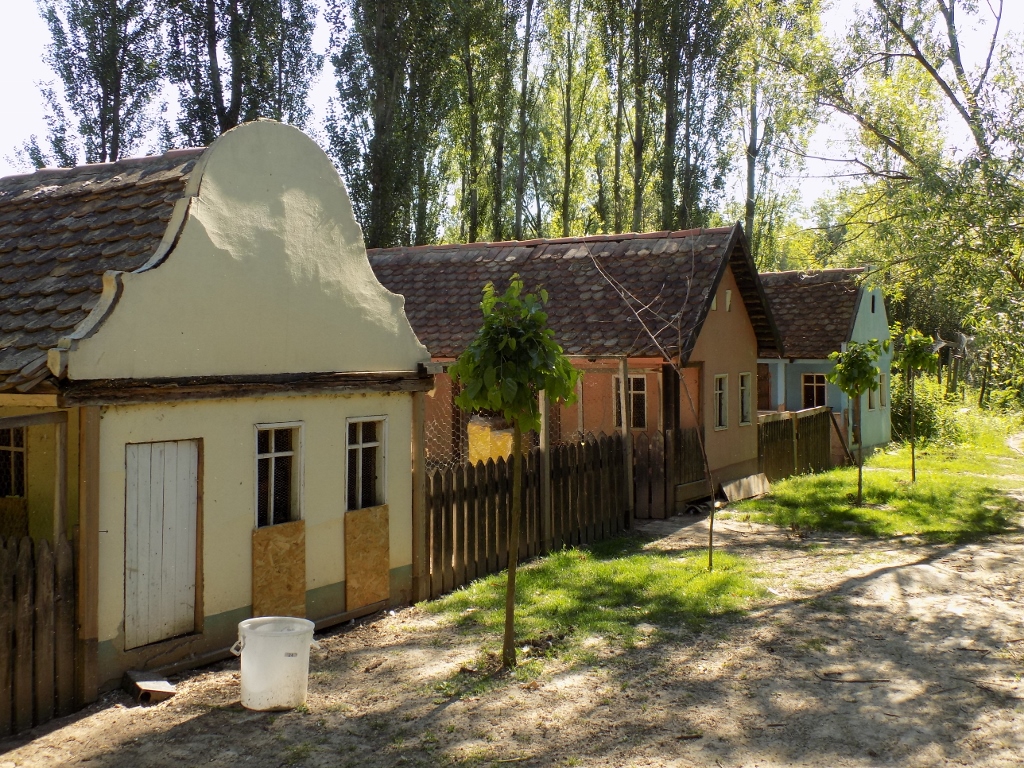 “Settlement” in the middle of a forest
“Settlement” in the middle of a forest
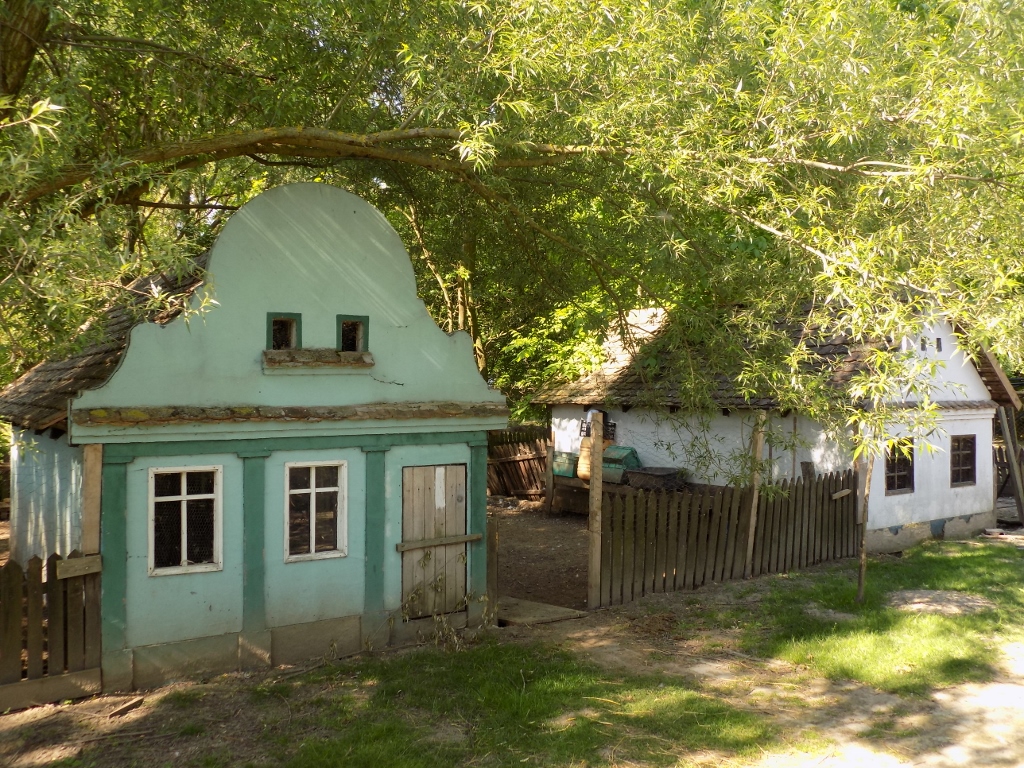 “Settlement” in the middle of a forest
“Settlement” in the middle of a forest
In fact, these small houses built in the traditional style were used as henhouses. You should first look at their size – in the first photograph I accidently included a large bucket in front of the “entrance” and there you can see that the house is smaller than the regular houses. On the other hand, in the “courtyard” of one of these small houses I also saw the residents – the chicken. The other “households” were currently empty.
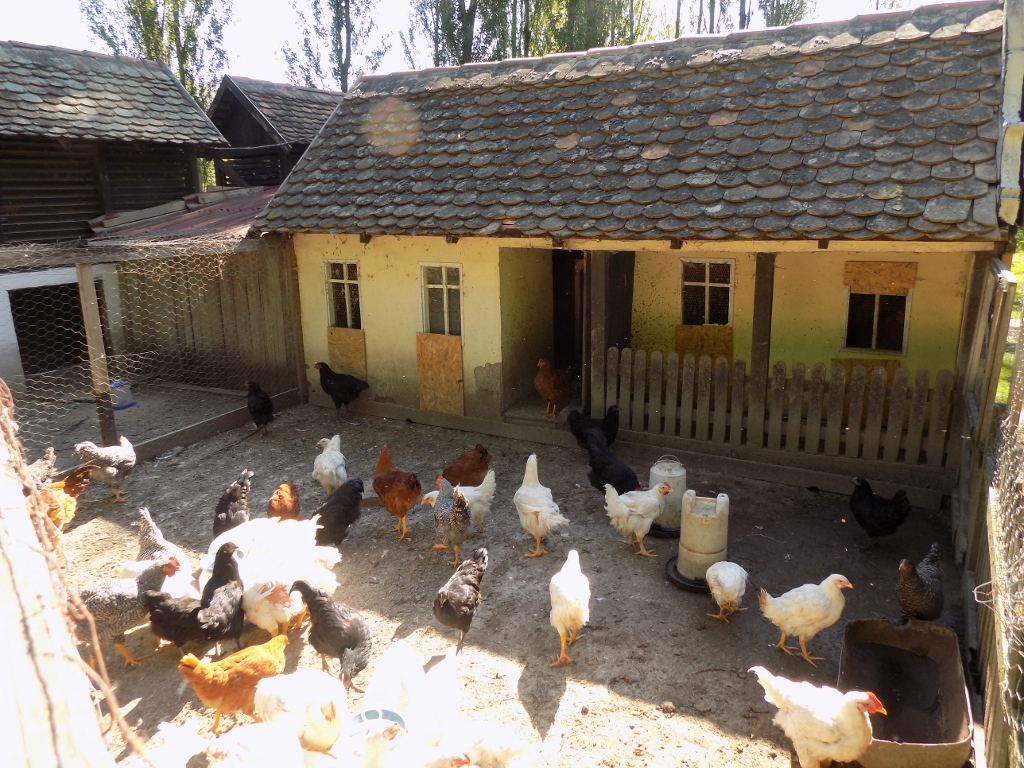 Residents of a small house in a forest
Residents of a small house in a forest
I don’t know actually what these houses are doing here, but they certainly looked very picturesque. I continued along the path and thus I got to a lawn where I saw a flock of geese. I remembered that geese can be aggressive sometimes, but these here were quite fine and they completely ignored me.
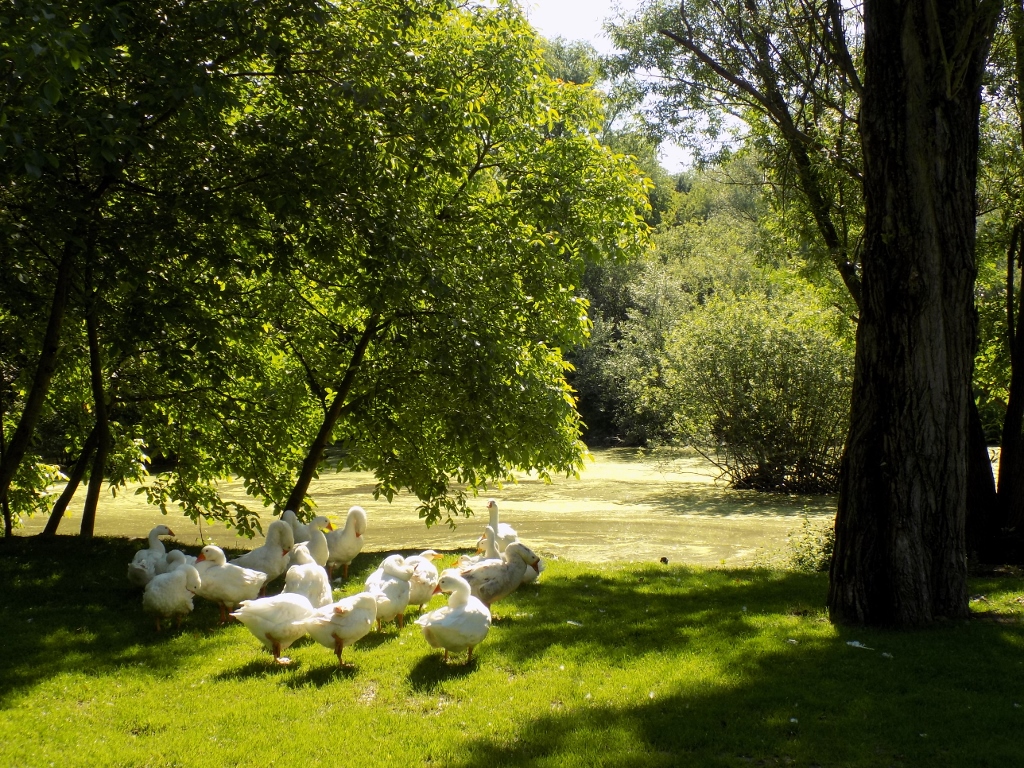 Flock of geese
Flock of geese
From this spacious lawn in which I saw the geese I also saw a small bridge that led to the main house in the property and since I did not see any sign that would prohibit the passage, I continued along my way for I just wanted to pass there and move on. As it can be seen in the photo, it was all perfectly peaceful and deserted, so I thought I would not bother anybody and nobody would even notice that I passed through there.
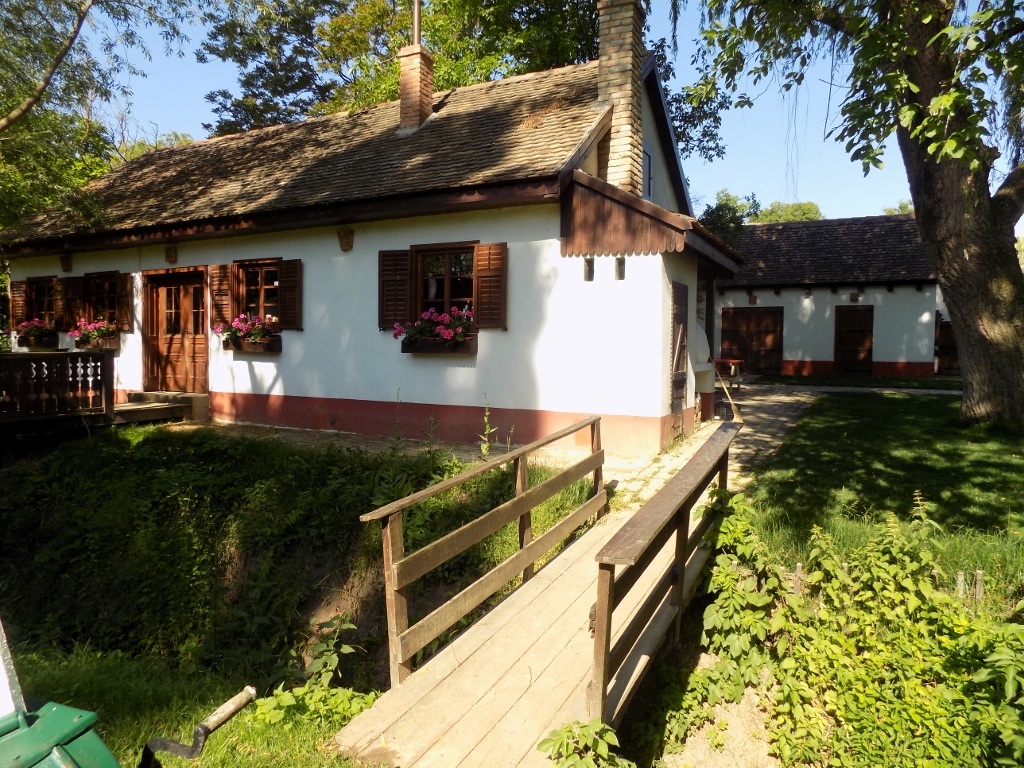 Picturesque household on the edge of a forest
Picturesque household on the edge of a forest
However, a few metres after I had crossed the bridge, some dogs, 4 or 5 of them, came out of nowhere and started to bark at me like mad. I stopped on the spot and they surrounded me. I tried to talk to them and calm them down, but I actually did not know what to do. I thought of going back, but even a very light movement of my body backwards led them to bark even harder. Luckily, I am not afraid of dogs, but I certainly did not feel pleasant at all. I was standing there quite confused and tried to calm them down with my talk, but then luckily the owner of the property came out of the house and got hold of the biggest dog saying he was particularly dangerous. Although the owner grabbed his collar, the dog kept barking at me and then the owner called some other man who eventually took over that loudest dog and led him away from there. The owner then told me that they (the dogs) were only guarding the property, which was quite clear to me anyway, and he was worried lest they had injured me. They did not. I apologised for coming there uninvited, but the owner was truly not concerned about that at all and I think that he just felt relieved that his dogs did not maul a casual passer-by.
Still, this situation had its significant silver lining. I took the opportunity to ask the owner of the property about the way back to the hotel, hopefully without going back along the same path that had brought me there in the first place. As it turned out, there is no proper circular path around the lake, but rather from there I had to follow some dirt roads that in a few spots moved away from the lake relatively a lot. I was not concerned about it. This owner explained it all very well to me, so I thanked him and continued with my walking.
Close to this house start large apple plantations and walking past their perimeter I could enjoy once again the bright red colour of the field poppies.
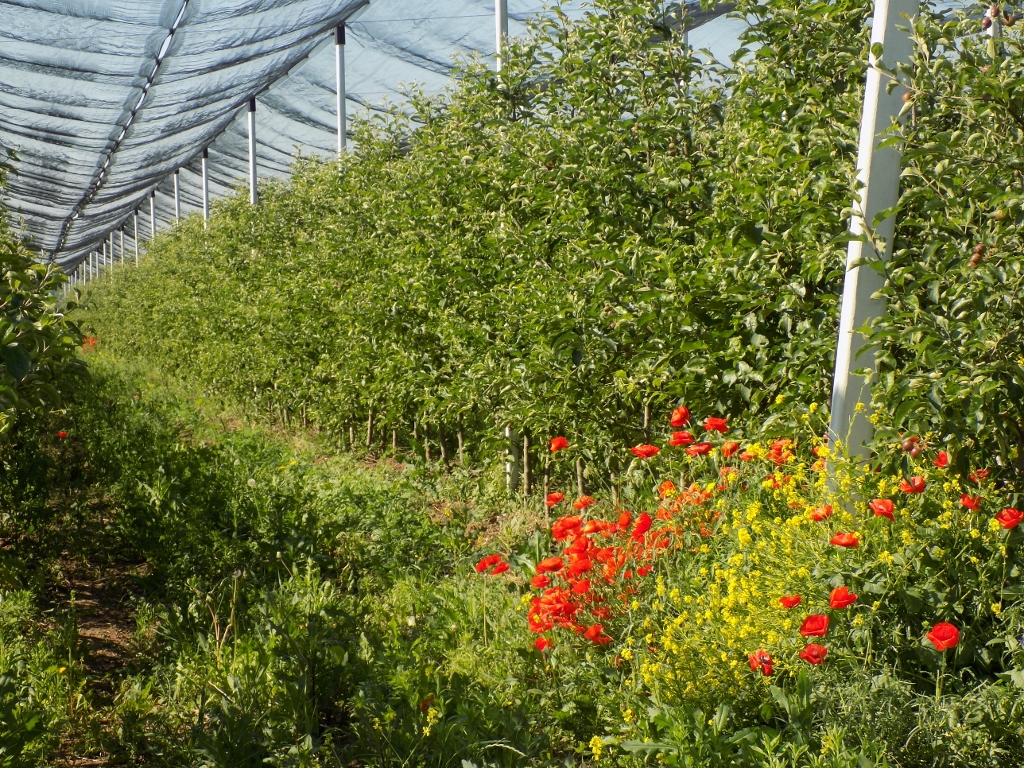 Apple plantation
Apple plantation
Suddenly, on a nearby transmission line I noticed something exceptionally interesting – these were my first European bee-eater (Merops apiaster) seen in “person.”
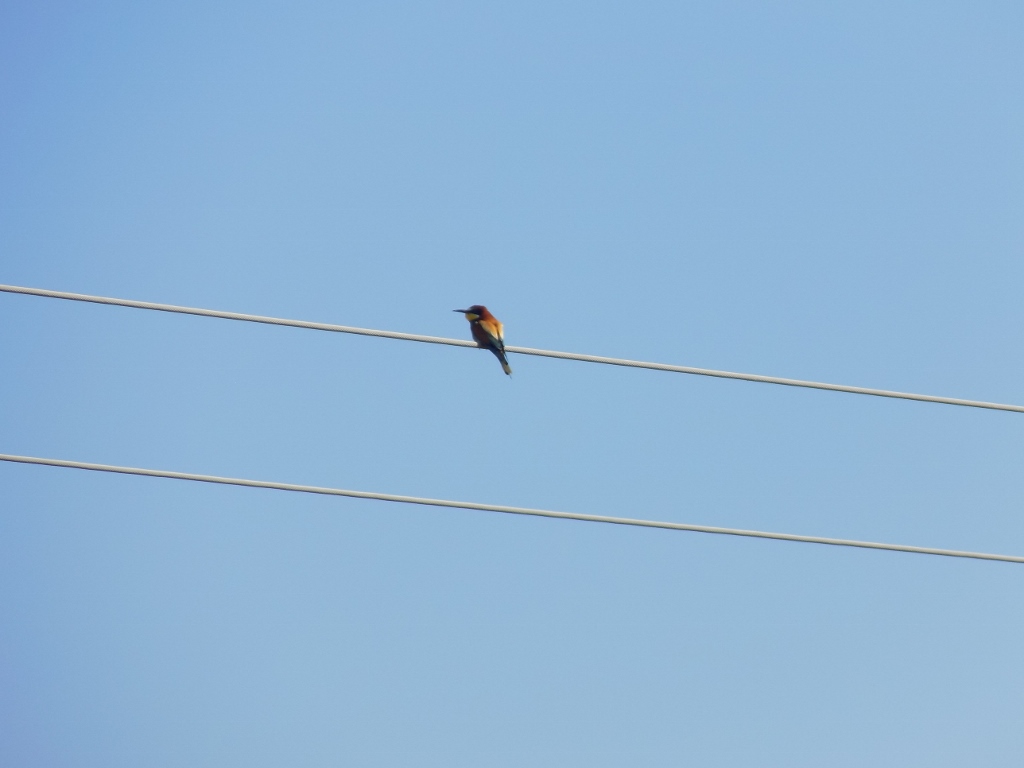 European bee-eater
European bee-eater
Although I used the zoom on my photo camera, I still could not get much closer to them than what is seen in the photo. This is a migratory bird that spends winters in tropical Africa and because of its abundant colours I find it to be one of the most beautiful birds in our region. Although its colours could be partially seen in the photo above, following is a photo that is not good at all, but there I caught a European bee-eater with its wings spread, which allows for a better appreciation of its colourful feathers.
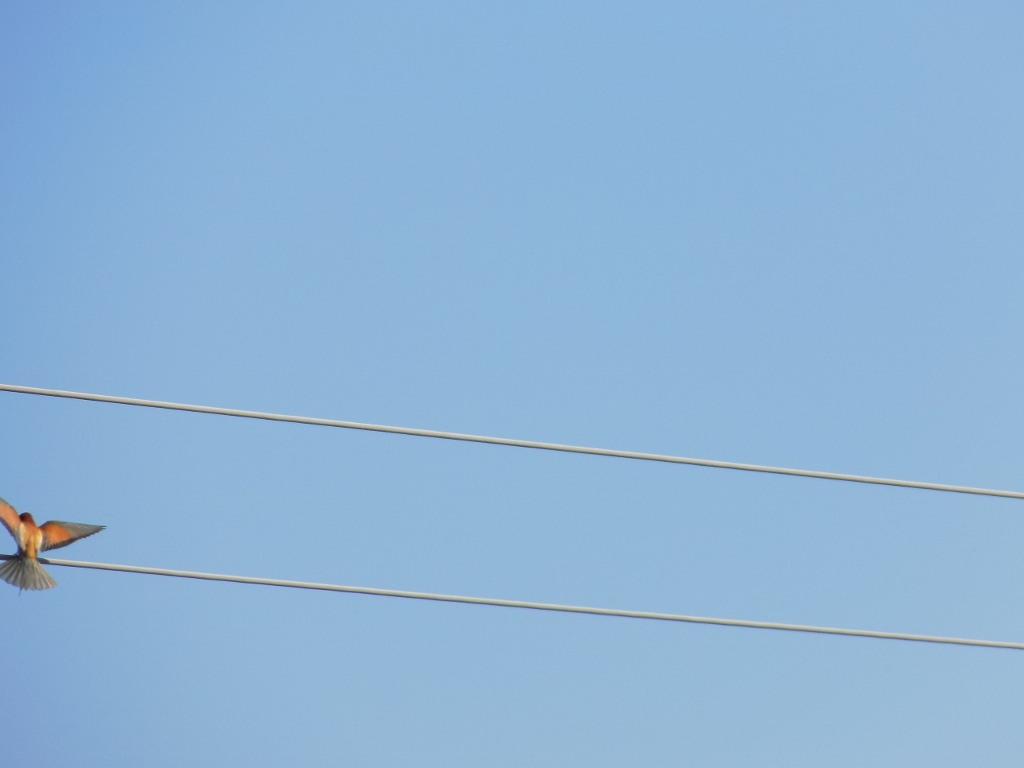 European bee-eater with its wings spread
European bee-eater with its wings spread
I was very content because of these European bee-eaters and so I continued with my walking and soon I got to an elevation from which I could see a part of the lake.
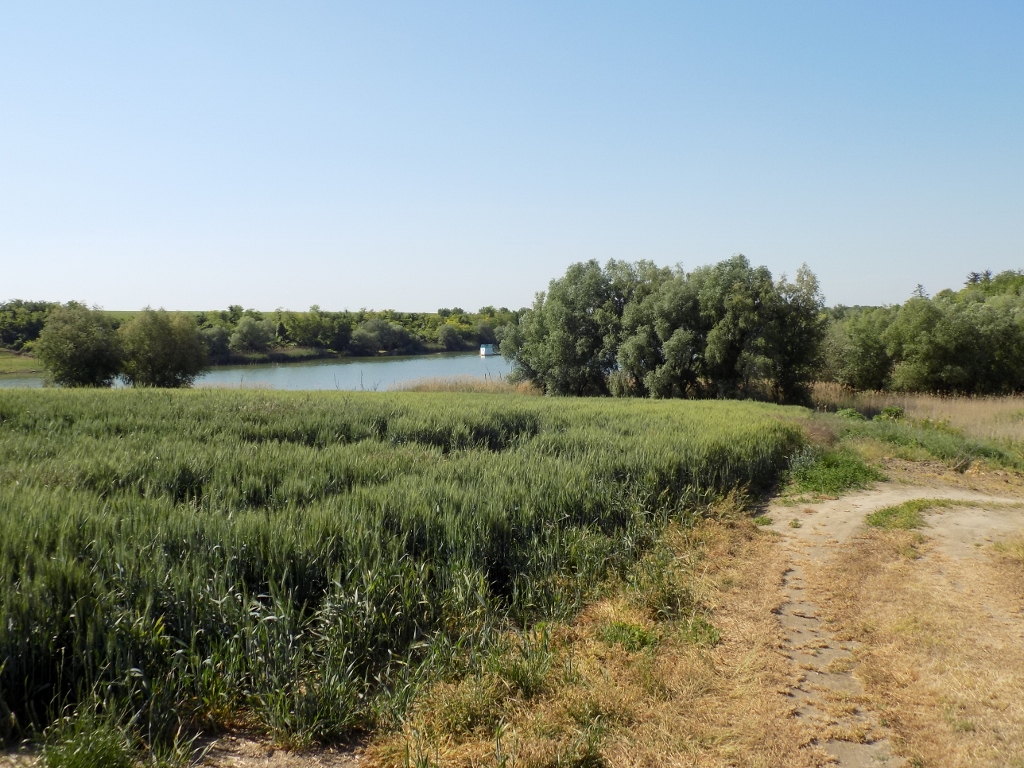 Borkovačko Lake a little farther away from the road
Borkovačko Lake a little farther away from the road
Still, the road led me in the opposite direction, but I followed it nonetheless. It was certainly worth the while, since the landscapes were very beautiful.
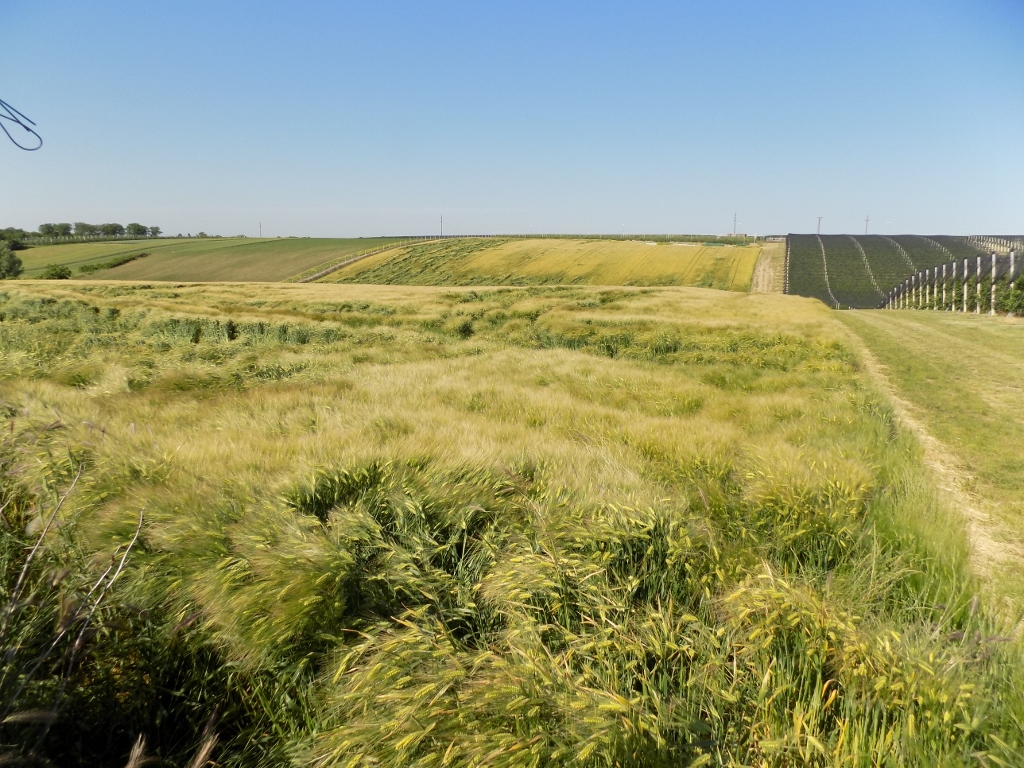 Fields and plantations
Fields and plantations
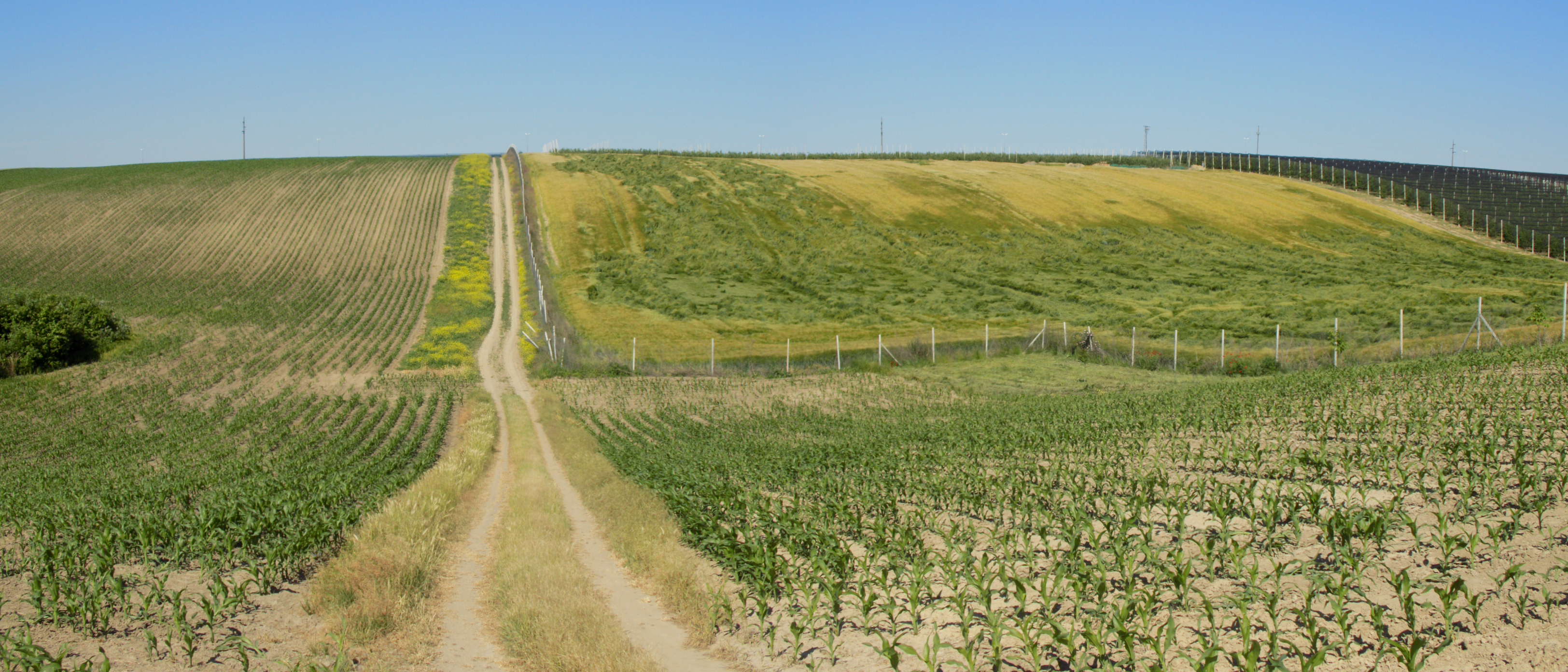
The road in front of me went a little down, then a little up and when I got to its lowest level I stopped once again to take photos. Here, several field poppies decorated the blossoms of the rapeseed growing there beside a large field probably on its own and as a left over from some earlier years where it may have been growing in the entire field.
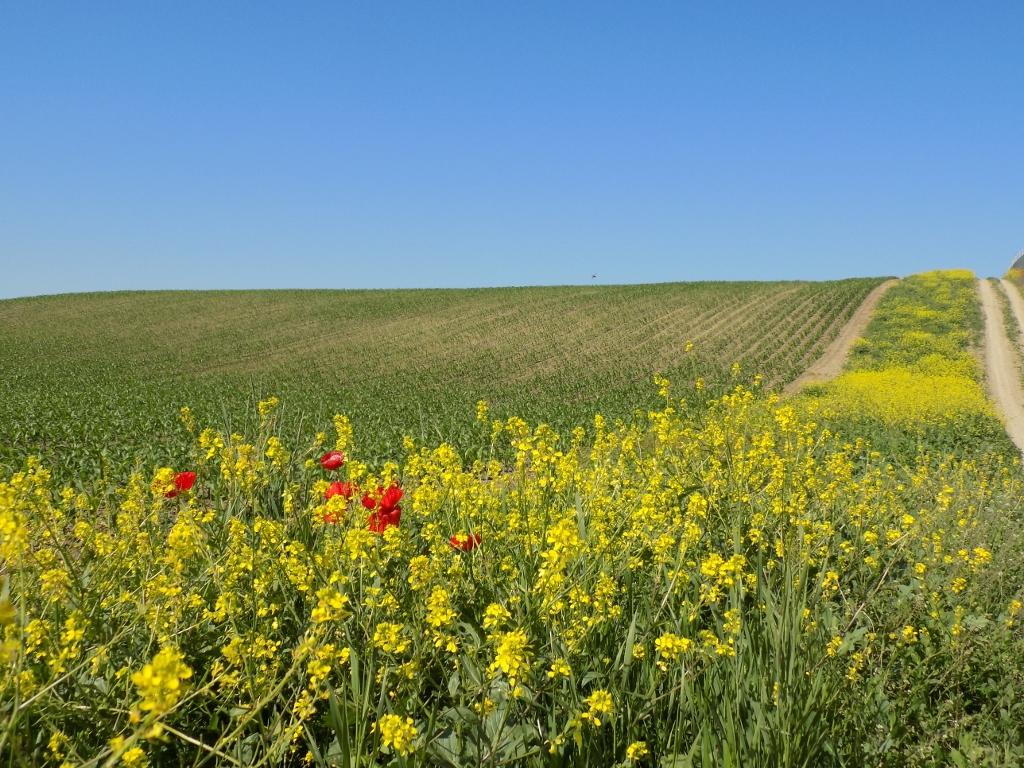 Agricultural Syrmia
Agricultural Syrmia
And when I started to walk up the elevation, in addition to the field there was also the spectacularly blue sky in front of me. This was quite enough for my soul to be filled with beauty.
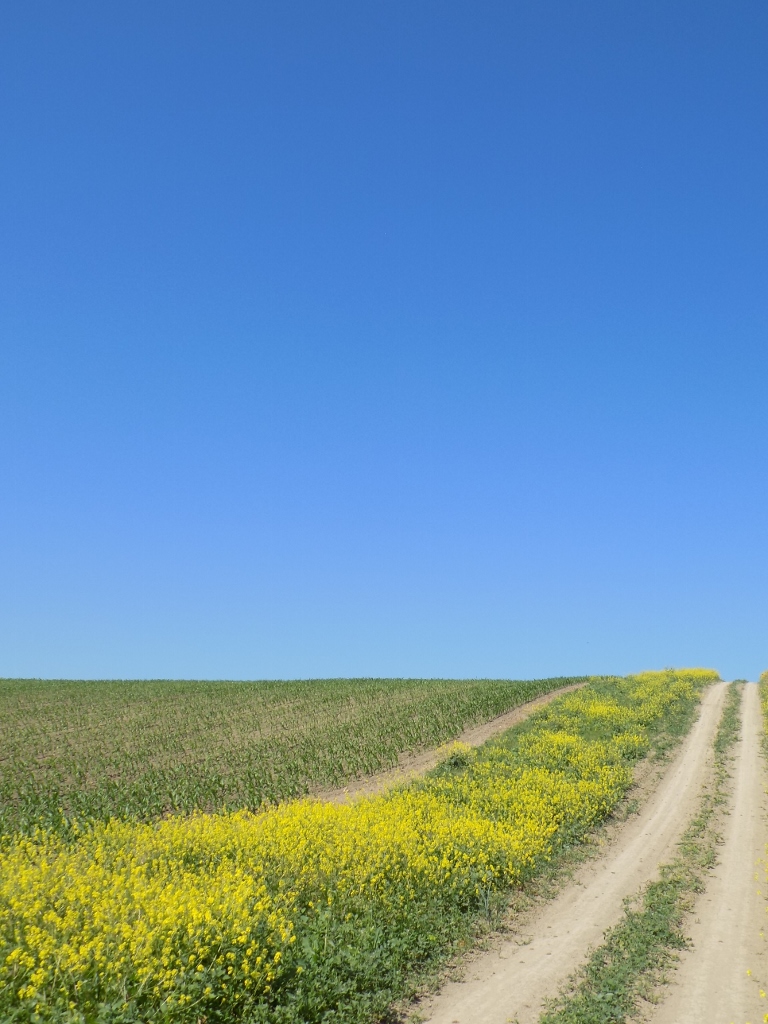 Agricultural Syrmia and the sky above it
Agricultural Syrmia and the sky above it
After some 20 minutes I reached the hotel, right on time to have my breakfast there and then I got ready to start with some monument of culture sightseeing.